Life Is Better Today than in the Past Essay
Introduction, how life in modern times different from that of the past, society then and now.
Although most individuals may argue that the world is at the verge of destruction, because of the increased civil wars, environmental problems such as global warming, and the ever-increasing gap between the rich and the poor, the quality of life in the contemporary society is far much better than it was fifty years ago.
It is very hard to imagine how life was fifty years ago when most products of technology were not present. As compared to historical communities, present societies are more developed, democratic, diverse, and all-inclusive. In addition, people’s health has improved; individuals can interact freely; the transportation system is better, and communication is easy and fast.
Therefore, although every innovation and development cannot lack some form of negative effects, the world is a better place than it was fifty years ago; hence, the need for every individual to appreciate and always struggle to make the world a better place for both present and future generations.
One primary fact that every individual should attest to is that, as compared to fifty ago, nowadays the quality of healthcare is better and more responsive to the ever-changing health condition of the world.
Unlike in the past when diseases such as small pox, measles, pneumonia, and even HIV and AIDS were a threat to the human existence, presently, majority f these diseases can be cured, and for those that cannot be cured there are numerous control measures or vaccines to control their spreading.
This like scenario has been made possible by the increasing research endeavours in the medicine world aimed at making the world a healthy place. As a result of the improved health condition, nowadays individuals can afford to live long and productive life spans with little fears of the likelihoods of a disease arising that will lack a cure.
Although some individuals may argue that some diseases are incurable; hence, to some extent the world is stagnant somewhere in terms of health, it will be so illogical to compare the health status of the world fifty years with the present situation, where even life supporting machines exist.
In addition to an improved quality of health, because of the numerous products of technology such as the computer, numerous aspects of life have improved greatly.
With the internet nowadays individuals can send or receive information from any part of the world within short time spans. Moreover, with numerous products of technology such as the television, presently individuals are always updated with any occurrences and information from any part of the world.
This cannot be compared to fifty years ago when the few radio and cable television sets that were available could only transmit their news within short distances. On the other hand, in the present world there exist numerous modern conveniences that have made life easy.
For example, with the presence of microwaves, fridges, gas burners, washing machines, printers, fax machines, video decoders, and many other office and home electronic gadgets, individuals can perform all the office and home chores easily, faster, and more efficiently.
Another aspect of life that is far much better than it was some fifty years ago is the quality of education. With the internet and other forms of “sophisticated” modes of learning for example, distance education, e-learning, and virtual classrooms, nowadays individuals are able to learn from any geographical positions.
In addition, nowadays societies appreciate the importance of education to the wellbeing of the society, because of the numerous research endeavours aimed at improving the quality of life that are included in most present scientific studies.
As compared to some fifty years ago, the literacy level in most present societies is very high, as most present governments offer free basic education to its citizenry. As a result of this, the level of self-conscious and self-esteem is better in present societies, because more individuals are able to provide for their families using the practical concepts learnt in both formal and informal educational settings.
On the other hand, life in present societies is better, because of the increased respect of every individual’s fundamental civil rights. Most present day governments are democratic and respect the right of its citizenry, something that was rare in most past societies, because of the nature of power that was enjoyed by the ruling class.
Closely related with increased respect of civil rights, is the ever reducing racism and segregation on racial, social class or background basis. Nowadays societies have learnt to appreciate and live in harmony with one another; hence, the nature of peace that is enjoyed by the world and the freedom of movement from a society or country to another.
In conclusion, considering the present condition of the world economically, technologically, socially, and politically, the world of today is a better place to live in as compared to fifty years ago.
This is because modern conveniences and technological innovations have revolutionized how human do everything is done, without which life could be very hard to live. Although people were comfortable with their lifestyles fifty years ago, possibly it is because they had no knowhow any of the modern developments could have made their work better.
- Chicago (A-D)
- Chicago (N-B)
IvyPanda. (2023, October 29). Life Is Better Today than in the Past Essay. https://ivypanda.com/essays/life-today-is-better-than-fifty-years-ago/
"Life Is Better Today than in the Past Essay." IvyPanda , 29 Oct. 2023, ivypanda.com/essays/life-today-is-better-than-fifty-years-ago/.
IvyPanda . (2023) 'Life Is Better Today than in the Past Essay'. 29 October.
IvyPanda . 2023. "Life Is Better Today than in the Past Essay." October 29, 2023. https://ivypanda.com/essays/life-today-is-better-than-fifty-years-ago/.
1. IvyPanda . "Life Is Better Today than in the Past Essay." October 29, 2023. https://ivypanda.com/essays/life-today-is-better-than-fifty-years-ago/.
Bibliography
IvyPanda . "Life Is Better Today than in the Past Essay." October 29, 2023. https://ivypanda.com/essays/life-today-is-better-than-fifty-years-ago/.
- Is Alex in Burgess' "A Clockwork Orange" Cured?
- Baby With HIV Is Deemed Cured
- Organisational Development and Change
- BJ’s: Profiting in Recessionary Times
- Democratic Rule and Educated Citizenry
- Dubai Tourism Promotion and Commerce Marketing
- Essential Foundations of the Public Relations
- Google Inc's Corporate Strategy
- The Blindness That Can Be Cured: Some Cultural Aspects of Manager’s Responsibilities
- The Right to Abortion
- Social Theories of Crime in Explaining Gang Violence
- How Does Culture Affect the Self Identity Personal Essay
- Subculture Theories: Response to the Dominant Culture
- Negative Impact of Internet on Society Essay
- Multi-Occupancy Buildings: Community Safety
Read our research on: Abortion | Podcasts | Election 2024

Regions & Countries
Worldwide, people divided on whether life today is better than in the past, current economic conditions a key factor in assessing progress.
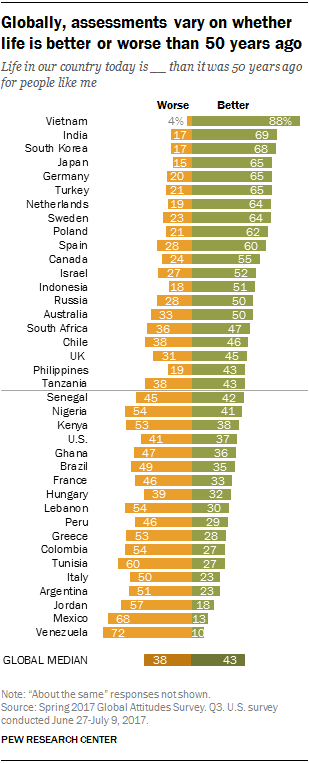
Numerous countries found themselves at important crossroads – whether it was military conflict between Israel and its Arab neighbors, civil rights and war protests in the U.S., or Soviet tanks crushing Czechoslovakia’s Prague Spring.
How far do people around the globe think they and others like them have come, compared with 50 years ago? Pew Research Center put that question to nearly 43,000 people in 38 countries around the globe this past spring.
At a country level, some of the most positive assessments of progress over the past 50 years are found in Vietnam (88% say life is better today), India (69%) and South Korea (68%) – all societies that have seen dramatic economic transformations since the late 1960s, not to mention the end of armed conflict in the case of Vietnam. A majority in Turkey (65% better) also share a sense of progress over the past five decades. In some of the more developed countries, publics also report that life is better today, including 65% in Japan and Germany, and 64% in the Netherlands and Sweden.
But not everyone is convinced that life today is an improvement over the past. Americans are split on this issue : 41% say life is worse while 37% say better. Meanwhile, half or more in countries ranging from Italy (50%) and Greece (53%) to Nigeria (54%) and Kenya (53%) to Venezuela (72%) and Mexico (68%) say life is worse today.
In general, countries that are more upbeat about their national economy are more likely to say life today is better compared with the past. For example, in Vietnam, where 91% say economic conditions are good, a corresponding 88% say life is better for people like them compared with 50 years ago. And in Venezuela, where only 20% say conditions are good, 10% say life is better for people like them. Overall, the correlation between economic assessments and views of the past is quite strong (+0.68).
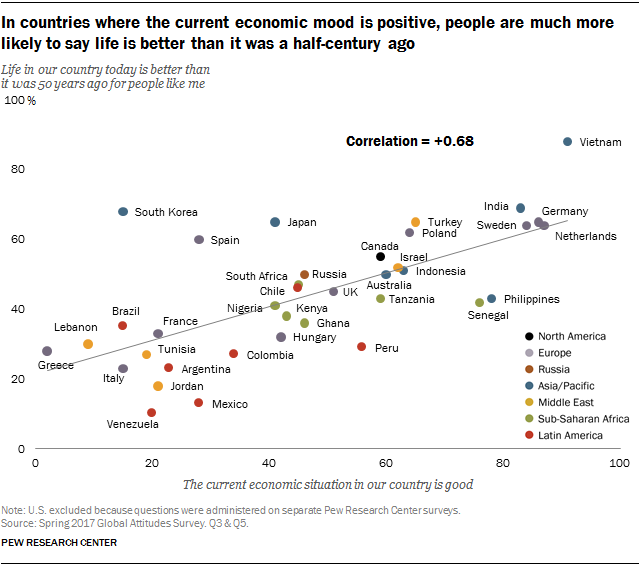
These are among the major findings of a Pew Research Center survey conducted among 40,448 respondents in 37 countries from Feb. 16 to May 8, 2017. A separate survey in the U.S. was conducted June 27-July 9, 2017, among 2,505 respondents.
Regional variations in assessments of present vs. past
Latin Americans stand out for their widespread negative assessment of progress over the past half-century. Venezuelans and Mexicans (72% and 68% life is worse) are the most downbeat, but nowhere in the region do more than half say life has improved for people like themselves.
Across the Middle East and North Africa, views of life today compared with 50 years ago vary substantially by country. Turkey reports the most progress in the region, with 65% saying life is better, followed by Israel, where 52% say the same about their country. Tunisians, Jordanians and Lebanese tend to say life has gotten worse for people like them, with Tunisians expressing the most widespread negativity (60%).
In sub-Saharan Africa, comparative assessments of present and past are more evenly divided. A median of 46% say life today is worse than five decades ago, compared with 42% who think life is better. Positive ratings of progress range from 47% “better” in South Africa to 36% in Ghana.
Nigeria and Kenya are the only countries surveyed in the region where more than half say life is worse (54% and 53%, respectively).
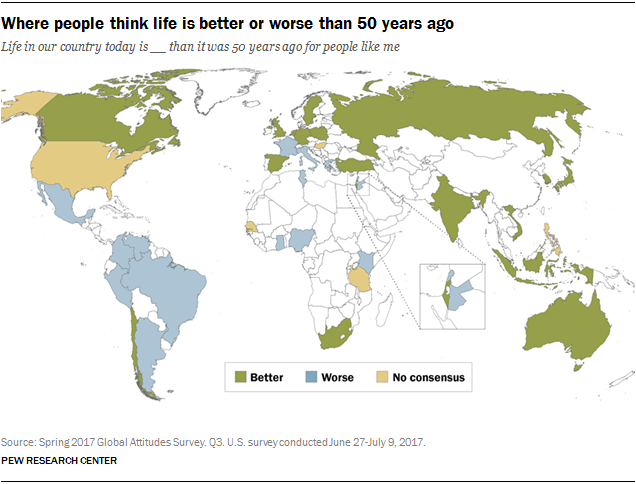
Europeans tend to see the past half-century as a period of progress. A regional median of 53% describes life as better today, compared with 30% who take the opposite view. Upbeat assessments are most common in Germany (65% better), the Netherlands (64%), Sweden (64%), Poland (62%) and Spain (60%). Greeks (53% worse) and Italians (50%) are the least convinced that life is better than 50 years ago.
The Asia-Pacific region is home to some of the most favorable assessments of progress. Vietnam (88% better) stands out, but views of life today vs. the past are also quite rosy in India (69%), South Korea (68%) and Japan (65%). Filipinos are the least sanguine about progress, with fewer than half (43%) saying life is better.
In North America, Canadians widely report progress over the past five decades (55%) while fewer Americans (37%) say the same about life in their country. In the U.S., Republicans are more likely to say life is better today , compared with Democrats – an attitudinal shift in the wake of Donald Trump’s election as president in November 2016.
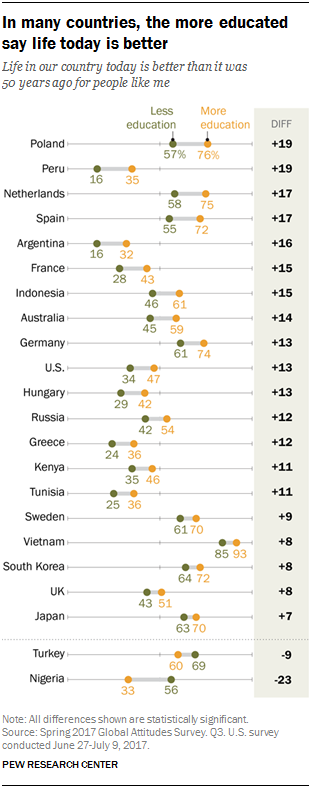
The more educated are more likely to say life is better
The reverse pattern, with less educated more optimistic about life today, is seen in just two countries: Nigeria (by 23 points) and Turkey (9 points).
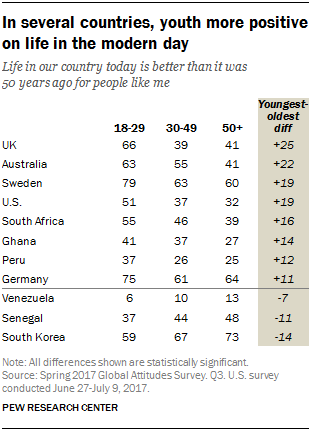
Age differences also appear in Australia, Sweden, the U.S. and Germany among advanced economies, and in South Africa, Ghana and Peru among emerging economies.
There is a reverse pattern on age in South Korea, where 73% among those 50 and older say life is better now compared with 59% who say this among 18- to 29-year-olds. This pattern is also found in Senegal and Venezuela.
Divisions within countries point to perceived gains and loses
In some countries polled, views about who has gained and lost over the past half-century divide sharply along religious or ethnic lines.
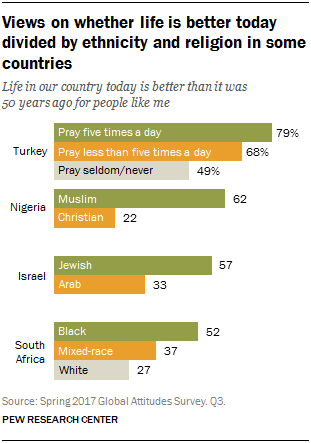
In Nigeria – home to both Muslims and Christians, but now governed by an elected Muslim leader – Muslims are much more enthusiastic about their country’s progress. Nearly three times as many Nigerian Muslims as Christians (62% vs. 22%) say life is better today compared with 50 years ago.
In Israel, 50 years after the Jewish State was victorious in the Six-Day War against a coalition of Arab nations, Israeli Jews are far more convinced than Israeli Arabs that life today is better for people like them. Nearly six-in-ten Jews in Israel say life has improved, compared with only a third of Israeli Arabs who see similar progress.
And in South Africa, there is a sharp racial divide on social progress: Blacks in the country, who a half-century ago were oppressed via the apartheid system, are much more likely to say life is better today for people like them (52%), compared with mixed-race (or “coloured”) and white South Africans (37% and 27%, respectively).
Political divides on life today in Europe
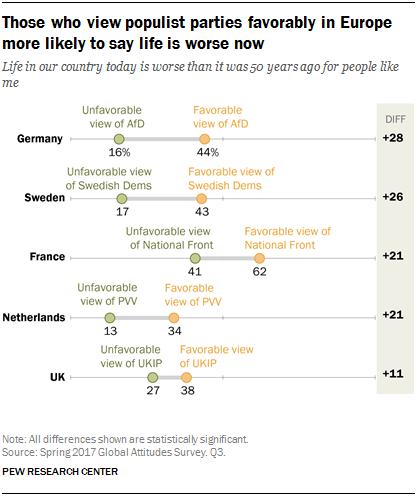
For example, Germans who support the Alternative for Germany party (AfD) are 28 percentage points more likely to say that life is worse off for people like them than those who have an unfavorable view of the anti-immigrant party. This pattern also holds in Sweden among supporters of the Swedish Democrats, in France among those with a favorable view of National Front, in the Netherlands among PVV supporters and in the UK among fans of the UK Independence Party (UKIP).
- Ghana and Italy excluded due to insufficient sample size on reported income. U.S. excluded because questions were administered on separate Pew Research Center surveys. ↩
- For the purpose of comparing education groups across countries, we standardize education levels based on the United Nations’ International Standard Classification of Education. The lower education category is below secondary education and the higher category is secondary or above in Argentina, Brazil, Chile, Colombia, Ghana, India, Indonesia, Jordan, Kenya, Lebanon, Mexico, Nigeria, Peru, Philippines, Senegal, South Africa, Tanzania, Tunisia, Turkey, Venezuela and Vietnam. The lower education category is secondary education or below and the higher category is postsecondary or above in Australia, Canada, France, Germany, Greece, Hungary, Israel, Italy, Japan, Netherlands, Poland, Russia, South Korea, Spain, Sweden, UK and U.S. ↩
Sign up for our Global newsletter
Delivered twice a month
Report Materials
Table of contents, what makes life meaningful globally, answers sometimes vary by age, where americans find meaning in life has changed over the past four years, where people around the world find meaning in life, what makes life meaningful views from 17 advanced economies, how americans feel about the satisfactions and stresses of modern life, most popular.
About Pew Research Center Pew Research Center is a nonpartisan fact tank that informs the public about the issues, attitudes and trends shaping the world. It conducts public opinion polling, demographic research, media content analysis and other empirical social science research. Pew Research Center does not take policy positions. It is a subsidiary of The Pew Charitable Trusts .
20 big ways the world has changed since 1999
- The dawn of the new millennium was just under 20 years ago.
- The world we live in now is completely different from then.
- Here are all the biggest changes.

As we get closer and closer to 2019, it's hard not to look back on the years past and reflect on how different everything is now. Twenty years ago, in 1999, the world was a completely different place than it is today.
We were on the dawn of a new millennium, stressed and unsure about what Y2K would bring. Cell phones were only just beginning to become popular, social media was not yet the number one topic of conversation, Britney Spears had just dropped her first album, and newspapers and magazines were still going strong.
Although 1999 might not feel that far away sometimes, when you think about how much the world has changed since then, it feels like it happened a million years ago. Here are a few more examples of how different our lives are today:
You're now on the internet more than you aren't on the internet, instead of just using it for school or work.
In 1999, the internet was still shiny and new, something that seemed to be full of exciting possibilities… we just didn't know how to use them yet. Most of the websites we know and love today weren't even a thought in 1999 — even Google had just become a thing about a year earlier.
Those who went online who were using the internet for school or work, not for entertainment or connecting with people. Today, the internet is obviously a huge part of our lives, and it's hard to imagine a time when it wasn't. More than 4 billion people have access to the internet.
Today, you can talk on the phone and use the internet at the same time.
In fact, you can talk on the phone, watch TV, scroll through social media on your iPad, and read a different website on your computer if you really wanted to. Back in 1999, dial-up was necessary to connect to the internet , and so we all found ourselves getting kicked off the phone if someone tried to get online, or waiting for our family members to end their conversations so we could log on.
You no longer have to worry about breathing in secondhand smoke when going out to eat.
It wasn't until the early 2000s that smoking bans in restaurants really went into effect. In 1999, you were still able to go into a restaurant or bar that reeked of smoke, which wasn't a pleasant experience if you didn't smoke. Some restaurants had smoking and non-smoking sections because even that wasn't taken away until later on. Today, you don't have that problem, as smoking indoors is banned pretty much everywhere .
You now get more excited about television than you do about movies.
The last few years have been full of some truly excellent television, whether it's shows on cable TV or on streaming services. Everything is about TV right now, and there is no shortage of amazing shows to watch. There were plenty of good shows on in 1999 as well, of course (like "Sex and the City" and "The Simpsons"), but it was more about the movies than anything else.
Huge films like "Fight Club," "The Matrix," and "American Beauty" came out in 1999, and as New York magazine points out , "it was the best, most innovative year for American movies in recent memory."
That's a big change from the Golden Age of Television we're currently in , although you're much more likely to watch them on a computer or a computer hooked up to your TV than you were back then.
You no longer have to sit around hoping your Napster song download goes through.
Who can forget Napster? The file-sharing network was created in 1999 , and it was then that everyone started illegally downloading music for free instead of buying CDs. The service came with its fair share of issues, though, from songs that took hours to download to ones that ended up being the completely wrong file.
Today, you don't have to painstakingly download your music illegally, you can just listen to whatever you want on a streaming service like Spotify. It might not be free if you don't want to listen to commercials, but it's certainly more convenient.
You rent movies off Amazon Prime instead of heading to Blockbuster.
Back in 1999, Blockbuster was the place to be on the weekends. If you wanted to watch a specific movie or television show, you went to Blockbuster to hope it was on the shelves so you could rent it and watch it -- and return it promptly, or pay a hefty late fee. Blockbuster locations started closing in the early 2000s, and today, there is only one left.
Now, if you want to watch something, you either find it on Netflix or you rent it off of your TV's On Demand service or Amazon Prime, from the comfort of your own bed.
Eating at a restaurant has become a social experience.
Not only do Americans now spend more on bars and restaurants than they do on grocery shopping , according to Bon Appetit, but in 2018, food has been just about presentation as it is about taste.
In 1999, you have grabbed a dinner on date night as a special treat, today people are consuming over-the-top, colorful internet food so they can snap a picture as well as grab a bite.
You can no longer go on vacation and truly take a break from everything.
Back in 1999, cell phones were not so common that even toddlers owned them. In fact, even if you did have one, you didn't get service everywhere you went, especially if you traveled somewhere new.
And since WIFI and tablets weren't a thing either, you could go on vacation and actually be away from everything, with no ability to check your email or get text message updates from friends.
Today, you can't do that unless you choose to go off the grid. And even then, t here is likely still the urge to check your phone.
Many people see terrorist attacks a more of a looming threat today.
Of course, terrorism existed in 1999, and it was something people worried about — but it wasn't yet in the back of their head as something to stress over during everyday life. It wasn't until after the Twin Towers fell in New York due to the attacks on 9/11 (in 2001) that terrorism became a much more real threat for many.
In fact, according to Vox, peoples' fears in the US have stayed elevated today after 9/11 to about the level they were just after the 1995 Oklahoma City bombing. They also pointed out that the likelihood of a terrorist attack is much smaller than say, the threat of a car accident.
It's worth noting that w hile much of the world has seen an increase in terrorism , the rate of death from a terrorist attack has actually decreased as of 2017.
You probably also have a much bigger fear of mass shootings today than you did 20 years ago.
Again, mass shootings existed in 1999 in the US, but they weren't talked about as often. The Columbine High School shooting happened in 1999, and although it wasn't the first mass shooting or the first school shooting, it was a huge event.
Today, mass shootings are happening on a much more regular basis in the US. T he days between mass shooting occurrences went from 200 days on average during the period of 1983 to 2011 to 64 days since 2011, according to the Harvard Injury Control Research Center .
You now get updates from the president of the United States on Twitter.
Today, President Donald Trump often uses Twitter as a means of communication, something that was unheard of in 1999 — both because things were different, and because Twitter wasn't invented yet. In 1999, you waited to hear what Bill Clinton had to say on television or in a newspaper.
You no longer have to memorize anyone's phone numbers.
In 1999, cell phones were nowhere near as popular as they are today. If you wanted to keep track of someone's number, you either wrote it down in an address book, or you memorized it so you could call them whenever you needed to. Think about it: do you know anyone's number by heart anymore? Probably not.
You text instead of leaving voicemails.
Even if you did have a cell phone in 1999, you didn't text people all the time. If you couldn't get in touch with them, you left a voicemail on their answering machine. Coming home to find you had messages was kind of exciting. Today, noticing that you have a voicemail is usually just horribly annoying.
Everyone has a smartphone, and most people don't even know what a Nokia is.
If you did have a cell phone in 1999, chances are good that it was a clunky Nokia. Nokia's were used for making calls and playing the snake game, and that was it. iPhones didn't come around until 2007 .
You have to take your shoes off when you fly now.
Today, you know going into a flight that you're going to have to remove your shoes when going through airport security. In 1999, you didn't have to do that, because no one considered shoes to be a threat. That didn't happen until the shoe bomber of 2001 .
Online dating is the norm today.
Online dating was around in 1999 ( Match.com was created in 1995 ), it just wasn't something people admitted to taking part in. Back then, it was considered taboo, something people did only if they were desperate. Today, people embrace online dating apps and online dating has lost much of its stigma, according to Pew.
Today about 5% of Americans who are married or in a committed relationship say they met their partner online.
You have the option to watch television without commercials.
Another great thing about TV today? If you pay for streaming services like Netflix and Hulu, you can nix commercials completely. If you DVR something, you can simply fast forward through them. In 1999, you didn't have that option, unless you wanted to attempt to record something on a VHS tape and then fast forward.
You now take photos on your cell phone instead of a film camera.
In 1999, disposable cameras were everywhere, and you didn't go out for the night without one. People took photos, then waited days or weeks for the film to get developed before having the chance to see how they turned out. Today, you use your cell phone instead of a camera, and you see your pictures immediately.
You use Google Chrome instead of Internet Explorer.
The web browser of choice in 1999 was Internet Explorer. Today, it's Google Chrome , and it's a whole lot more advanced.
You make playlists instead of burning CDs.
If you wanted to listen to specific music in 1999, you made CDs full of the random songs you liked, then kept them stored in little plastic books. Today, you just put together a quick playlist on a streaming service and listen to it from your cell phone.
Visit INSIDER's homepage for more.
- Main content
- Skip to main content
- Keyboard shortcuts for audio player
Is Life Better Now Than 50 Years Ago? The Answer May Depend On The Economy

Ashley Westerman

People eat at a noodle stall at the Han Market in the central Vietnamese city of Danang in November. Vietnamese respondents to the Pew Research Center survey overwhelmingly said life is better than it was 50 years ago. Ye Aung Thu/AFP/Getty Images hide caption
People eat at a noodle stall at the Han Market in the central Vietnamese city of Danang in November. Vietnamese respondents to the Pew Research Center survey overwhelmingly said life is better than it was 50 years ago.
The way people perceive their country's economic conditions plays a big role in whether they view their lives more positively now compared with the past, according to a study released Tuesday by the Pew Research Center.
Of the nearly 43,000 people surveyed in 38 countries in Asia, Europe, the Middle East, Africa and North and South America, Vietnam had the most positive self-assessment: Eighty-eight percent of respondents said life is better today in their country than it was a half-century ago.
Other Asian countries round out the top five, including India (69 percent), South Korea (68 percent) and Japan (65 percent).
At the opposite end of the survey, with the least positive assessment of their lives today, 72 percent of respondents in Venezuela said they are worse off. Bleak assessments were also reported by Mexico (68 percent) and Argentina (51 percent).
"Latin Americans stand out for their widespread negative assessment of progress over the past half-century," the report says.
The findings reported in "Worldwide, People Divided on Whether Life Today Is Better Than in the Past" are part of Pew's annual global attitudes survey. But this is the first time the organization has asked whether life in a person's country is generally better, worse or the same as it was five decades ago, says senior researcher Jacob Poushter.
"We're interested in how people see sort of the changing nature of the world and how that affects their lives," he says.

Thirty-eight countries were included in the Pew Research Center survey. Pew Research Center hide caption
Thirty-eight countries were included in the Pew Research Center survey.
While the results are subjective and depend on the historical events and politics of each country, Poushter says the biggest takeaway from this survey is that economic outlook is an important factor.
"Exceptions aside about where actual countries were 50 years ago and what the history has been, it generally finds that economic satisfaction ... tends to be one of the strongest in terms of pushing people to say life is better or worse," says Poushter.
For example, in Vietnam, 91 percent of respondents said economic conditions are good. According to the World Bank, Vietnam has become among the world's fastest-growing economies and is projected to continue that upward swing.

The Two-Way
Venezuela will create new 'petro' cryptocurrency, president maduro says.
In Venezuela, with the highest percentage of people saying life is worse, only 20 percent of respondents said the economy was good. A collapse of international oil prices has greatly affected Venezuela's economy, which is almost solely reliant on fossil fuels. Things have become so dire that the Venezuelan government announced this month it would create a cryptocurrency to combat high inflation and replace its virtually worthless currency, the bolivar.
While the correlation between economic outlook and positive responses about life today was strong for most countries surveyed, it was not true in all cases — including the United States.
"There are countries which, if you look at objectively, are doing well economically but [respondents] still said that life was worse today than it was 50 years ago," says Poushter. "Oftentimes, you see ... more issues with politics, issues with relatively more recent history, in terms of people more upset about where they are compared to 50 years ago."
Among U.S. respondents, 37 percent said their lives are better and 41 percent said they are worse.

Anti-government looters attacked a supermarket in Venezuela's Carabobo state in May. Seventy-two percent of Venezuelans told the Pew Research Center they were worse off than 50 years ago. Ronaldo Schemidt/AFP/Getty Images hide caption
Anti-government looters attacked a supermarket in Venezuela's Carabobo state in May. Seventy-two percent of Venezuelans told the Pew Research Center they were worse off than 50 years ago.
A lot of that comes down to political divisions, says Poushter.
"It's just that in the last year, Republicans have become more likely to say life is better off, and Democrats have become less likely to say their lives are better off," he says.
Political divides also were apparent in Europe, where those supporting populist parties such as the Alternative for Germany or France's National Front were more likely to say "life is worse off for people like them," the report says.
The report finds education level is also a factor affecting whether people see their lives as better now than five decades ago.
In more than half the countries polled, respondents with a higher level of education said that for people like themselves, life was better.
The greatest educational divide can be seen in Poland, where 76 percent of more educated people said life was better than in the past. Fifty-seven percent of the less educated felt that way. The only two countries where the less educated saw their lives as better today were Nigeria and Turkey.
Further, in some countries surveyed, the perceived gains and losses by certain religious and ethnic groups over the last 50 years played a factor in respondents' answers. For example, the survey found that black respondents in South Africa are "much more likely" to say life is better (52 percent) than it was 50 years ago, when the country was living under an apartheid system. Just 27 percent of white South Africans said the same.
- Pew Research Center
Greater Good Science Center • Magazine • In Action • In Education
Parenting & Family Articles & More
How teens today are different from past generations, a psychologist mines big data on teens and finds many ways this generation—the “igens"—is different from boomers, gen xers, and millennials..
Every generation of teens is shaped by the social, political, and economic events of the day. Today’s teenagers are no different—and they’re the first generation whose lives are saturated by mobile technology and social media.
In her new book, psychologist Jean Twenge uses large-scale surveys to draw a detailed portrait of ten qualities that make today’s teens unique and the cultural forces shaping them. Her findings are by turn alarming, informative, surprising, and insightful, making the book— iGen:Why Today’s Super-Connected Kids Are Growing Up Less Rebellious, More Tolerant, Less Happy—and Completely Unprepared for Adulthood—and What That Means for the Rest of Us —an important read for anyone interested in teens’ lives.
Who are the iGens?

Twenge names the generation born between 1995 and 2012 “iGens” for their ubiquitous use of the iPhone, their valuing of individualism, their economic context of income inequality, their inclusiveness, and more.
She identifies their unique qualities by analyzing four nationally representative surveys of 11 million teens since the 1960s. Those surveys, which have asked the same questions (and some new ones) of teens year after year, allow comparisons among Boomers, Gen Xers, Millennials, and iGens at exactly the same ages. In addition to identifying cross-generational trends in these surveys, Twenge tests her inferences against her own follow-up surveys, interviews with teens, and findings from smaller experimental studies. Here are just a few of her conclusions.
iGens have poorer emotional health thanks to new media. Twenge finds that new media is making teens more lonely, anxious, and depressed, and is undermining their social skills and even their sleep.
iGens “grew up with cell phones, had an Instagram page before they started high school, and do not remember a time before the Internet,” writes Twenge. They spend five to six hours a day texting, chatting, gaming, web surfing, streaming and sharing videos, and hanging out online. While other observers have equivocated about the impact, Twenge is clear: More than two hours a day raises the risk for serious mental health problems.
She draws these conclusions by showing how the national rise in teen mental health problems mirrors the market penetration of iPhones—both take an upswing around 2012. This is correlational data, but competing explanations like rising academic pressure or the Great Recession don’t seem to explain teens’ mental health issues. And experimental studies suggest that when teens give up Facebook for a period or spend time in nature without their phones, for example, they become happier.
The mental health consequences are especially acute for younger teens, she writes. This makes sense developmentally, since the onset of puberty triggers a cascade of changes in the brain that make teens more emotional and more sensitive to their social world.
Social media use, Twenge explains, means teens are spending less time with their friends in person. At the same time, online content creates unrealistic expectations (about happiness, body image, and more) and more opportunities for feeling left out—which scientists now know has similar effects as physical pain . Girls may be especially vulnerable, since they use social media more, report feeling left out more often than boys, and report twice the rate of cyberbullying as boys do.
Social media is creating an “epidemic of anguish,” Twenge says.
iGens grow up more slowly. iGens also appear more reluctant to grow up. They are more likely than previous generations to hang out with their parents, postpone sex, and decline driver’s licenses.
More on Teens
Discover five ways parents can help prevent teen depression .
Learn how the adolescent brain transforms relationships .
Understand the purpose of the teenage brain .
Explore how to help teens find purpose .
Twenge floats a fascinating hypothesis to explain this—one that is well-known in social science but seldom discussed outside academia. Life history theory argues that how fast teens grow up depends on their perceptions of their environment: When the environment is perceived as hostile and competitive, teens take a “fast life strategy,” growing up quickly, making larger families earlier, and focusing on survival. A “slow life strategy,” in contrast, occurs in safer environments and allows a greater investment in fewer children—more time for preschool soccer and kindergarten violin lessons.
“Youths of every racial group, region, and class are growing up more slowly,” says Twenge—a phenomenon she neither champions nor judges. However, employers and college administrators have complained about today’s teens’ lack of preparation for adulthood. In her popular book, How to Raise an Adult , Julie Lythcott-Haims writes that students entering college have been over-parented and as a result are timid about exploration, afraid to make mistakes, and unable to advocate for themselves.
Twenge suggests that the reality is more complicated. Today’s teens are legitimately closer to their parents than previous generations, but their life course has also been shaped by income inequality that demoralizes their hopes for the future. Compared to previous generations, iGens believe they have less control over how their lives turn out. Instead, they think that the system is already rigged against them—a dispiriting finding about a segment of the lifespan that is designed for creatively reimagining the future .
iGens exhibit more care for others. iGens, more than other generations, are respectful and inclusive of diversity of many kinds. Yet as a result, they reject offensive speech more than any earlier generation, and they are derided for their “fragility” and need for “ trigger warnings ” and “safe spaces.” (Trigger warnings are notifications that material to be covered may be distressing to some. A safe space is a zone that is absent of triggering rhetoric.)
Today’s colleges are tied in knots trying to reconcile their students’ increasing care for others with the importance of having open dialogue about difficult subjects. Dis-invitations to campus speakers are at an all-time high, more students believe the First Amendment is “outdated,” and some faculty have been fired for discussing race in their classrooms. Comedians are steering clear of college campuses, Twenge reports, afraid to offend.
The future of teen well-being
Social scientists will discuss Twenge’s data and conclusions for some time to come, and there is so much information—much of it correlational—there is bound to be a dropped stitch somewhere. For example, life history theory is a useful macro explanation for teens’ slow growth, but I wonder how income inequality or rising rates of insecure attachments among teens and their parents are contributing to this phenomenon. And Twenge claims that childhood has lengthened, but that runs counter to data showing earlier onset of puberty.
So what can we take away from Twenge’s thoughtful macro-analysis? The implicit lesson for parents is that we need more nuanced parenting. We can be close to our children and still foster self-reliance. We can allow some screen time for our teens and make sure the priority is still on in-person relationships. We can teach empathy and respect but also how to engage in hard discussions with people who disagree with us. We should not shirk from teaching skills for adulthood, or we risk raising unprepared children. And we can—and must—teach teens that marketing of new media is always to the benefit of the seller, not necessarily the buyer.
Yet it’s not all about parenting. The cross-generational analysis that Twenge offers is an important reminder that lives are shaped by historical shifts in culture, economy, and technology. Therefore, if we as a society truly care about human outcomes, we must carefully nurture the conditions in which the next generation can flourish.
We can’t market technologies that capture dopamine, hijack attention, and tether people to a screen, and then wonder why they are lonely and hurting. We can’t promote social movements that improve empathy, respect, and kindness toward others and then become frustrated that our kids are so sensitive. We can’t vote for politicians who stall upward mobility and then wonder why teens are not motivated. Society challenges teens and parents to improve; but can society take on the tough responsibility of making decisions with teens’ well-being in mind?
The good news is that iGens are less entitled, narcissistic, and over-confident than earlier generations, and they are ready to work hard. They are inclusive and concerned about social justice. And they are increasingly more diverse and less partisan, which means they may eventually insist on more cooperative, more just, and more egalitarian systems.
Social media will likely play a role in that revolution—if it doesn’t sink our kids with anxiety and depression first.
About the Author

Diana Divecha
Diana Divecha, Ph.D. , is a developmental psychologist, an assistant clinical professor at the Yale Child Study Center and Yale Center for Emotional Intelligence, and on the advisory board of the Greater Good Science Center. Her blog is developmentalscience.com .
You May Also Enjoy

This article — and everything on this site — is funded by readers like you.
Become a subscribing member today. Help us continue to bring “the science of a meaningful life” to you and to millions around the globe.
Intellectual Roundtable
Asking — and answering — life's interesting questions
Is Life Today Better Than In The Past?
If you were able to accurately evaluate life today against life one hundred years ago, one thousand years ago, or even 10 thousand years ago, would we be able to determine which is better?
Humans have a tendency to overvalue what they know. We find it easy to believe that our country is the best. Or that our mother’s cooking can’t be beat. The neighborhood we grew up in was better than any other.
Similarly, we may believe that life today is better than the way people lived in centuries past. But is that actually true?
It is certainly true that our mastery of travel makes just about every corner of the globe is accessible. I can pack a bag, catch a flight, and be halfway around the world within 24 hours. (Assuming, of course, no travel restrictions.)
A trip to an average grocery store yields a remarkable variety of produce, and an almost dizzying array of processed food. The internet makes access to information nearly ubiquitous, and allows us to communicate with people without thought to geographical limitations. Lifespans are longer, literacy rates are higher, some previously deadly diseases have been all but eliminated.
However, each of these things have downsides. Easy travel is at the expense of burning fossil fuels, which is contributing to climate change. The same can be said about produce that travels thousands of miles to those well-stocked grocery stores. And all that processed food has brought about a crisis in obesity.
While communication is easier with the internet, social media apps are making us more polarized and as such we hear each other less. What good is a longer lifespan if we use those extra hours sitting in traffic jams and overall leading more stressed lifestyles?
Are the negatives worth the positives? Is life today better than in the past?
Related questions: How have we changed? Past, present, or future? Is it fair to judge the past with morals of today? Are we too busy?
Spread the word about Intellectual Roundtable:
4 thoughts on “is life today better than in the past”.
In many aspects — technological gains, the slow progress of recognizing human rights, worldwide abject poverty steadily decreasing — things are getting better. I cannot dispute this, nor would I want to.
But today, I’m deciding to focus on the moral life of America when asking, “Is life today better than in the past?”
Our addiction to independence seems focused on rights without accepting responsibilities. And we dare not challenge this addiction without a gaggle of politicians and rabble-rousers derisively shouting, “Socialism!” to inflame their base.
Let’s face it. America, when considering virtue, is sorely deficient. As a society, we don’t ask, “How much is enough?” We too often think of strangers as enemies, especially if they come from other countries. And, humility is not one of our strong suits.
A few points to make this clearer: – While we are only 4.25% of the world’s population, we consume 24% of the energy. – We don’t change our consumptive behaviors, even though California is burning and hurricanes are hammering the Gulf Coast, saying nothing of the droughts we are forcing upon, say, South Africa or the island nations we are slowing making disappear. – A good portion of Americans can’t be bothered to wear a mask, even though it may mean we are saving a loved one’s life.
Recall that once we joined the allies in WWII, households brought in their metal to be melted and repurposed for war efforts, many people grew a significant portion of their foods in “Victory Gardens” to assist in nationwide rationing, and our workforce was transformed as men went to war, women took to the factories.
We remade society to address the crisis.
Are we transforming America and coming together to deal with climate change or the pandemic? Far from it! Instead, we are experiencing a tremendous and dangerous divide.
What will it take to make for an engaged and responsible citizenry? When will we accept that our actions impact those around us and those living in other countries?
America, wake up!
Well stated, Michael. I think it would be beneficial to discover why our sense of community responsibility has so declined. I know we don’t absolutely need to know the cause to ignite a solution, but I think that it helps. My parents and their friends did so much in the community I grew up in. Some of that involvement still exists, but it seems as if people are too busy these days, or they invest their time in frivolous activities that merely entertain or relax them. It’s time for some inspiration from local people as well as state and national people to chip in and make life better for communities and the nation as a whole. Had the national government been able to muster such inspiration, the Covid-19 crisis could have been such a time for Americans to come together. I don’t know that Biden/Harris and their teams are going to be able to change the nay-sayers attitudes and behaviors, but I am hopeful that they can achieve somethings in this area.
I guess it all depends on what your definition of “better” happens to be.
I think we know more, and knowing more is always better (even if we don’t always use that knowledge as we should).
I believe that life is better for most of us in convenience and possibilities than ever before. As for becoming perfectly moral in our behaviors, I don’t think we ever will be because we are still animals and therefore will probably forever retain a bit of wildness. Otherwise we must become robots. We can continue to be kinder, but I think that must include understanding and forgiving ourselves and others for our bit of wildness.
Leave a Reply Cancel reply
Your email address will not be published. Required fields are marked *
Notify me of follow-up comments by email.
Notify me of new posts by email.
IELTS Blog & IELTS Mock Test
Ielts exam preparation for a higher band score., differences between life in your country in the past and today.
IELTS Essay:
Topic: Life changes over time so do the people in a country. What are the differences between life in your country in the past and today?
Sample Answer 1: Changes are inevitable and over time the way of people live changes and so do the culture and tradition of a country. I am 28 years old and have witnessed how the lifestyle of people have changed over the decades. I will explain those changes from my experience.
To begin with, the most striking change is the paradigm shift of family structure. Joint families were the most common family types in our country but nuclear families are predominant these days. Second, the embrace of technology is quite noticeable. There is scarcely anyone who does not use a smartphone and have the Internet connection. Things were different in the past. In the early 1980’s computers were unknown to people while this is a very common device in every household these days.
People in the past loved to socialise and they had a simple way of life. However, people in my country, especially in urban areas, are busy and have little time to socialise. This is a striking change and I believe this busy life has also brought many negative consequences to the society. Furthermore, in terms of people’s career, a great transformation has already occurred. There were only a handful of job types in the past but with the time the number of different careers has increased remarkably.
Finally, the swelling population these days have increased the competition in every sphere of life. This includes getting admitted to a school to securing a position in a reputed company. Life was not that much competition in the past.
In conclusion, I have witnessed many changes in terms of people’s lifestyle in my country and those changes include family structure, people’s acceptance of technological development, increasing competition and loosely social bonding.
Sample Answer 2: (Country: Myanmar)
Life was simpler over twenty years ago in Myanmar. People used to live in individual houses rather than in apartments. No tall building or big shopping complex could be found in the downtown area of the city Yangon. Nowadays, you can find skyscrapers where people lives and business runs their offices around the city.
At the same time, the way people commute also has changed. Many people now have the automobiles though most people had to rely on public transportations before. Many cars in the city area lead to congestion as well as pollution.
Moreover, communication becomes much easier as the technologies have improved. From rich to poor, everyone uses mobile phones to connect with friends and families. The advanced technologies take Myanmar which has been closed and isolated for almost sixty years into the world. People, particularly younger generation, use social media to know what is happening around the world with just one simple click.
The improvement in technologies allows people to have a better health and education services. Young people have a window of opportunities to learn different languages and sophisticated computer technologies within the country or even take the distance learning course from other countries.
However, the social and cultural values have been affected. People spent less time with the families and have to work longer. It affects their social life and brings impacts to their society. Within a decade, the way people live, commute and communicate has changed in Myanmar. With the changes, the society may have good and bad impacts. Despite these consequences, the life of people in Myanmar surely continues to be changed as time flies.
[ Written by – Htet Htet ]
Leave a Reply Cancel reply
Your email address will not be published. Required fields are marked *
CAPTCHA 9 × = sixty three
- Lesson Plans
- Teacher's Guides
- Media Resources
Then and Now: Life in Early America, 1740–1840

Boy's frock or gown, 1800s.
Wikimedia Commons
Have you ever heard the expression, "The more things change, the more they stay the same?" Do you agree? Do your students? Does that old adage correctly characterize changes in America since the time of the Revolution? Using archival materials, re-creations, and classroom activities, help your students think about which aspects of everyday life — and the people who've lived it — have changed and which have stayed the same in the last 200 years.
Guiding Questions
In what ways is everyday life today significantly different from everyday life 200 years ago?
Learning Objectives
Compare the lives of people 200 years ago and people today.
Evaluate how changes in household tools, communication, transportation, recreation, and technology have changed the way people live and work.
Lesson Plan Details
NCSS.D2.His.1.6-8. Analyze connections among events and developments in broader historical contexts.
NCSS.D2.His.2.6-8. Classify series of historical events and developments as examples of change and/or continuity.
NCSS.D2.His.3.6-8. Use questions generated about individuals and groups to analyze why they, and the developments they shaped, are seen as historically significant.
NCSS.D2.His.4.6-8. Analyze multiple factors that influenced the perspectives of people during different historical eras.
NCSS.D2.His.5.6-8. Explain how and why perspectives of people have changed over time.
NCSS.D2.His.14.6-8. Explain multiple causes and effects of events and developments in the past.
NCSS.D2.His.15.6-8. Evaluate the relative influence of various causes of events and developments in the past.
NCSS.D2.His.16.6-8. Organize applicable evidence into a coherent argument about the past.
- Review each lesson in this unit and select archival materials you'd like to use in class. Bookmark these materials, along with other useful websites, if possible; download and print out selected documents and duplicate copies as necessary for student viewing. URLs are provided for direct access to the images used in the lesson; simply click on the link to access any image. Home page URLs also are provided to credit sources and to allow for further exploration as desired.
- This unit consists of a series of brief lessons. Lessons could be conducted as whole-class activities, or students could work independently at stations. Where sufficient technology is available, computers can serve as learning centers. The five images in Activity 2 can be displayed in five windows on one computer screen or separately on five or even ten computers (for five or ten groups). In a computer lab, a few of the activities can be conducted simultaneously. If desired, adult aides or older students could be assigned to stations to assist students.
- The activities are organized chronologically and would be most effective presented that way. The first seven activities represent aspects of everyday life from about 1740 to the early 1800s. The last five activities represent aspects of everyday life from the late 1700s to the mid-1800s. These two sets of activities could be used at different times during the year, depending on your curriculum. If desired, pick and choose from among the activities, using any particular lesson when it is appropriate for your class.
- Dried corn husks (the inner husks are better than the outer ones)
- Cotton string
- Water and container for it
- Small piece of corncob, horse chestnut, large wooden bead, ping pong ball or styrofoam ball (optional)
- A read-aloud activity is often a great way to establish an anticipatory set. One book particularly pertinent to this unit is Turn of the Century , written by Ellen Jackson and illustrated by Jan Davey Ellis (Charlesbridge Publishing, 1998; ISBN: 088106369X; Reading level: Ages 9-12, younger for reading aloud).
- Refer to the complementary EDSITEment lesson Reading, Writing, and 'Rithmetic in the One-Room Schoolhouse , which encourages students to compare and contrast school life in the one-room schoolhouse of the 19th century with the modern schools of today.
Activity 1. What Would Change in This Picture? (mid-1700s)
Share with your students an artist's rendering of Life in London Town from the EDSITEment-reviewed website Learning from London Town . If someone were to photograph the exact same street today, what would be different? Depending on the class, students can brainstorm the differences in a whole-group setting, work in small groups to create a list of changes, or create a contemporary update of the picture through drawing or cutting and pasting directly on the picture (enlarged, if possible). Create a class list of the items that would change in the picture and how they would be updated.
Activity 2. The More Things Change, the More They Stay the Same (1750–1800)
Have students list the differences, if any, between the following common objects from 1750–1800, all featured on the EDSITEment resource At Home in the Heartland Online , and similar objects we use today:
- An armchair
- A copper pot (or cauldron)
Activity 3. Getting Dressed in the 18th Century
Note: The interactive activity featured in this lesson focuses on 18th-century girls' clothing. For more information, including facts about boys' clothing, consult Children's Clothing and A Colonial Child's Clothing: A Glossary of Terms , both available on the website of Colonial Williamsburg , a link from the EDSITEment resource Internet Public Library. The activity can be completed online and/or offline using the doll and its accessories, which can be downloaded and printed out. When using the game online, the correct images must be chosen in order. If the images in the game dissolve when dragged, open a second window. Each time you toggle back to the window with the game, the images should be in place.
If using the game offline, print out copies of the doll and clothing for each student, have each student dress the paper doll and then compare the order of clothing items each student chose. The teacher can then demonstrate the correct order, and the class can discuss the purpose of each item of clothing. In this interactive activity — Eighteenth-Century Paper Doll Game — students will see all the steps it took for an 18th-century girl to get dressed. What steps in the process are the same today? What is completely different about getting dressed in the 18th century? What kind of outfit is this girl wearing? Do you think all children during this time period dressed in such fancy clothes?
Activity 4. You Gotta Make a Living (1750–1800)
Have students view the following images from the website of Colonial Williamsburg , a link from the EDSITEment resource Internet Public Library, of 18th-century people at work:
As a class or working in small groups, brainstorm what each picture reveals. What does the person do for a living? What is the person doing in the picture? Which of these jobs no longer exist? Which jobs exist in another form? Which jobs are very much the same? An alternative activity would be to have students match the early American job with a picture of a similar modern job. How was the 18th-century job different?
Activity 5. Let's Go Shopping (1750–1800)
Ask your students to write about or illustrate how they shop for medicine, shoes and/or clothing. After scrutinizing the images listed below, from the website of Colonial Williamsburg , a link from the EDSITEment resource Internet Public Library, have students brainstorm and create a list of the differences in the process.
- An apothecary shop
- Buying shoes
- Buying a dress
Activity 6. Bet You Can't Guess! (late 1700s to early 1800s)
Have students carefully observe the following images of items from the late 18th and early 19th centuries, all available on The Five Points Site , a link from the EDSITEment resource ArchNet , and form a hypothesis about the purpose of each object. A "hint" question is provided with each image link to help students guess the purpose of each of the items.
- Dessert glass with pattern-molded ribbing, 18th century How do you like your pudding served?
- Salt Cellar, late 18th century Got salt?
- Medicine Bottles, late 18th century Time to take your medicine?
- White granite chamber pot and lid What do you do when you have to go to the bathroom in the middle of the night?
- Clay and Glass Marbles, probably from the early19th century Did somebody lose their marbles?
- Red Earthenware Bank Where do you keep your money?
Now reveal the true function of each object. How close were the students' guesses? Note: For learning stations, the answer, something akin to the riddle-like questions above, or a picture of the modern equivalent of each object, could be attached to the back of the downloaded images.
Activity 7. Bet You Can't Guess! -- Part 2 (c. 1800–1840)
Have students carefully observe the following images of items from the early 19th century, all available on the EDSITEment resource At Home in the Heartland Online , and form a hypothesis about the purpose of each object.
- Candle Mold In 1800, you would need this even when you weren't getting ready for someone's birthday.
- Milk Pan (for separating the cream from the milk) Here's where the cream rises to the top.
- Lamp All the better to see you with!
- Yarn Winder Now you know how much yarn you have!
Now reveal the true function of each object. How close were the students' guesses? Note: For learning stations, the answer, something akin to the riddle-like questions above, or a picture of the modern equivalent of each object could be attached to the back of the downloaded images.
Activity 8. The More Things Change, the More They Stay the Same - Part 2 (c. 1800–1840)
Have students list the differences, if any, between the following objects from 1800–1840, all available on the EDSITEment resource At Home in the Heartland Online , and similar objects we use today.
- Spoon (made from horn)
The teacher can select a few of the objects and explain the context and uses for them. For instance, the milk pan can be used to explain the process of getting milk from cows and making cream, butter, etc., both in the past and with today's dairy farms and supermarkets, refrigerated trucks, pasteurization, etc. The yarn winder can be used to explain how clothes were made, then and now. The teacher can explain the processes of shearing sheep or picking cotton, carding, spinning, etc. The teacher can relate the yarn winder to the spinning wheels depicted in the tales of Sleeping Beauty and Rumpelstiltskin .
Activity 9. Digging Up the Past
How do we know about everyday life in early America? Students can be "online archaeologists" through the EDSITEment resource Learning from London Town's Virtual Dig . Using the inventory chart , students can determine the functions of the objects they find. Using the EDSITEment resource, Learning from London Town , the teacher can describe what an archaeologist does: learns about past cultures by studying the remains left behind by people. Teachers can introduce students to the idea of archaeology by having students perform " Digging the Cellar at Rumney's Tavern ," an interactive activity in which students become archaeologists and "dig" in the cellar by moving their mouse over the diagram of the drawing of the profile of the cellar dig at Rumney's Tavern. When the mouse arrow turns into a hand, a message appears at the bottom of the computer screen identifying the found object. Students then click on the screen to see a picture of their discovery.
Teachers can then ask: "How do these objects compare to the objects seen in the previous lessons? Where do these objects come from? How do we find objects from the past?" After completing Lessons 7 and 8, "Bet You Can't Guess!" and Lessons 2 and 9, "The More Things Change, the More They Stay the Same," teachers can use this complementary lesson to bring up overarching questions such as, "What do objects tell us about how the people who used them lived? How do we go about finding out what life was like at other points in history? Which objects from the past have remained part of our everyday life today?"
This interactive activity reinforces previous lessons about change and continuity from past to present and introduces the concepts of the archaeologist and of learning about earlier ways of life by uncovering objects of the past.
Activity 10. An Early American Game (1800–1840)
Give your students the opportunity to play an early American game. Games for both indoor and outdoor play may be found at Games to Try on Historic Latta Plantation , a link from the EDSITEment resource Women of the West Museum .
Activity 11. An Early American Toy (1800–1840)
Your students can create their own ball from corn husks and string. Instructions and background information may be found at Corn Husk Ball on Historic Latta Plantation , a link from the EDSITEment resource Women of the West Museum . After the students have had the chance to make and use the ball, encourage discussion. Did students find it challenging or difficult to make the corn husk ball? Do they have to work as hard for their toys today? Is the corn husk ball a fun toy to play with?
Activity 12. The Match Game
Culminate the lesson with a discussion based on the guiding question presented at the beginning of the unit: In what ways is everyday life today significantly different from everyday life 200 years ago? Attempt to arrive at a conclusion. Has everyday life changed radically, or is it basically the same? For example, is play essentially the same because students still throw and catch balls, or has such play radically changed since we use different balls? Have students represent their findings graphically. Using a bulletin board, computer, or some other type of display, students can post images of early American objects beside contemporary objects. They can even invite other classes to attempt to match the images.
For the Match Game, download the "Then and Now" chart, print it out, and and make copies for your students ( Download chart, which is Word format ).You can provide magazines for students to cut and paste images, or they can draw their own pictures, in the appropriate spaces on the chart. For each object, students can answer the questions, "What is it?" and "What is it used for?" Their responses can become the basis for a class discussion comparing life in the 18th and 19th centuries with life today.
- If you plan to invite other classes to your classroom, as suggested in Activity 12, make a celebration of it. Hold an Early American Fair, in which students display and/or demonstrate some of the objects they encountered in this lesson in booths.
- Students could be challenged to write stories with a time travel theme. What would happen if one of them were whisked back to early America? What would happen if someone from early America were whisked to modern times?
Selected EDSITEment Websites
- The Five Points Site
- At Home in the Heartland Online
- National Archives Education
- The Betsy Ross Homepage
- Carol Hurst Children's Literature Page
- Colonial Williamsburg
- Encyclopedia Britannica Online
- Learning from London Town
- Le Musée des arts et métiers, Paris
- Whole Cloth
- Notable Women Ancestors
- Historic Latta Plantation
Other Resources: Recommended reading from Carol Hurst Children's Literature Page , a link from Internet Public Library
- Hall, Donald. Ox-Cart Man . Illustrated by Barbara Cooney. (Audience: Grade 1)
Materials & Media
Then and now: life in early america: worksheet 1, related on edsitement, mission us: for crown or colony the game, american colonial life in the late 1700s: distant cousins, mapping colonial new england: looking at the landscape of new england, colonial broadsides and the american revolution.

ESSAY SAUCE
FOR STUDENTS : ALL THE INGREDIENTS OF A GOOD ESSAY
Essay: Living in the past present and future
Essay details and download:.
- Subject area(s): Philosophy essays
- Reading time: 2 minutes
- Price: Free download
- Published: 17 February 2021*
- File format: Text
- Words: 518 (approx)
- Number of pages: 3 (approx)
Text preview of this essay:
This page of the essay has 518 words. Download the full version above.
Some people claim that the living in the present can actually cause more harm than good. They say that in order to lead a productive and profitable life, one must study both the past and the future, the present is only a stepping stone. I think that this is quite the opposite. The past must be learned from, the future must be looked at, but the present is where things happen, where a person can make things happen.
In each persons time, he has the chance to make a mark upon the world. Each person can take his life into his own hands and decide what to do with it, how to mold it. These choices can often be hard to make. Frequently one’s opinions and choices are frowned upon by the establishment and by the majority. This must not let his faith and hope falter, he must strive to accept what he can not change, and change what he can not accept.
The world we know blazes past us every second. Our closest friends may soon leave forever, others may change, our old homes may be torn down to build a parking lot; yet time still marches on. I feel very strong that with guidance from our past and hope for our future we must live each day to its fullest, make each day more valuable than the previous. Life, love, and friendship are the most precious things on this earth, it is very important for each to find his true love and friends, and live his life with them to its fullest potential.
The past is just that, the past. There is nothing you can do about it except learn from it. In the last year I have spent countless hours contemplating what I could have done different to change the events that took place last October. The death of Jen Elliott, my friend, was the hardest thing I have ever experience in my short life. I would have given anything and everything to go back and change those events, and I still would. However, I have learned that there is nothing I can truly do, except learn from her and comfort her family. What I learned from her is that none of us know how long we will be here. We have to live each day like it is our last, because it may be.
The future, will always be the future. We have to set a goal as to what our futures will be and always keep that goal in sight. We mustn’t, though, let this goal take over our life. There will always be a future and a goal until the last minute. We have to take what we can now; be with our friends and family and care for them.
The past and the future are guideposts, beacons. They are not more. You can’t live in the past, you can’t get there. You can’t live in the future, you haven’t reached it yet. You must live in the present, or you haven’t lived at all.
...(download the rest of the essay above)
About this essay:
If you use part of this page in your own work, you need to provide a citation, as follows:
Essay Sauce, Living in the past present and future . Available from:<https://www.essaysauce.com/philosophy-essays/living-in-the-past-present-and-future/> [Accessed 01-04-24].
These Philosophy essays have been submitted to us by students in order to help you with your studies.
* This essay may have been previously published on Essay.uk.com at an earlier date.
Essay Categories:
- Accounting essays
- Architecture essays
- Business essays
- Computer science essays
- Criminology essays
- Economics essays
- Education essays
- Engineering essays
- English language essays
- Environmental studies essays
- Essay examples
- Finance essays
- Geography essays
- Health essays
- History essays
- Hospitality and tourism essays
- Human rights essays
- Information technology essays
- International relations
- Leadership essays
- Linguistics essays
- Literature essays
- Management essays
- Marketing essays
- Mathematics essays
- Media essays
- Medicine essays
- Military essays
- Miscellaneous essays
- Music Essays
- Nursing essays
- Philosophy essays
- Photography and arts essays
- Politics essays
- Project management essays
- Psychology essays
- Religious studies and theology essays
- Sample essays
- Science essays
- Social work essays
- Sociology essays
- Sports essays
- Types of essay
- Zoology essays

- Writing Correction
- Online Prep Platform
- Online Course
- Speaking Assessment
- Ace The IELTS
- Target Band 7
- Practice Tests Downloads
- IELTS Success Formula
- Essays Band 9 IELTS Writing Task 2 samples – IELTS Band 9 essays
- Essays Band 8 IELTS Writing – samples of IELTS essays of Band 8
- Essays Band 7 IELTS Writing – samples of IELTS essays of Band 7
- Essays Band 6 IELTS Writing – samples of IELTS essays of Band 6
- Essays Band 5 IELTS Writing – samples of IELTS essays of Band 5
- Reports Band 9 IELTS Writing – samples of IELTS reports of Band 9 (Academic Writing Task 1)
- Reports Band 8 IELTS Writing – samples of IELTS reports of Band 8
- Reports Band 7 IELTS Writing – samples of IELTS reports of Band 7
- Letters Band 9 IELTS Writing Task 1 – samples of IELTS letters of Band 9
- Letters Band 8 IELTS Writing – samples of IELTS letters of Band 8
- Letters Band 7 IELTS Writing – samples of IELTS letters of Band 7
- Speaking Samples
- Tests Samples
- 2023, 2024 IELTS questions
- 2022 IELTS questions
- 2021 IELTS questions
- 2020 IELTS questions
- High Scorer’s Advice IELTS high achievers share their secrets
- IELTS Results Competition
- IELTS-Blog App
IELTS Essay, topic: Learning about the past
- IELTS Essays - Band 6
Learning about the past has no value for those of us living in the present. Do you agree or disagree? Use specific reasons and examples to support your answer.
Evaluation of the importance of timing is essential, past to show the importance of their present, while that to even remember their past because it would not help them at all. It is a very controversial and complicated matter.

Moreover, success will not come without failure, everybody should make an attempt, even if it fails, and it may become a big success if they try it again and again. In addition, our past is our culture and heritage which we should not forget at all, it is a matter of value to our present and future, and will remain such till the day will die.
To sum up, in my opinion, we can not live without a past, it is our value of life. it can help create your experiences and solve your problems better in the future.
This essay is too short – it should be at least 250 words, writing less words means getting penalized. The structure of sentences needs work and so does the grammar. Do not address the “audience”, write in general (See the comments for the last sentence of the third paragraph). Overall, this looks like a Band 6 work. See comments underlined in blue for more details.
Click here to see more IELTS essays of band 6
Related posts:
- IELTS essay, topic: Is learning a foreign language essential or a waste of time (opinion)? This is a model response to a Writing Task 2...
- IELTS essay, topic: Children today are spending more time watching TV than in the past, is it a positive or a negative change? Today children are spending much more time watching TV compared...
- IELTS Report, topic: Multiple line graph describing the percentage of students learning a second language (from IELTS High Scorer’s Choice series, Academic Set 2) This is a model response to a Writing Task 1...
- IELTS essay, topic: Should school children be given homework (opinion)? This is a model response to a Writing Task 2...
1 thought on “IELTS Essay, topic: Learning about the past”
Pingback: IELTS Essay Samples of Band 6 | IELTS-Blog
Leave a Reply
Your email address will not be published. Required fields are marked *
Save my name, email, and website in this browser for the next time I comment.
- Fitness Freak
- Solar Energy
- Life Insurances
- Humorous Stories
- Money On Router
- Laughable Absurd
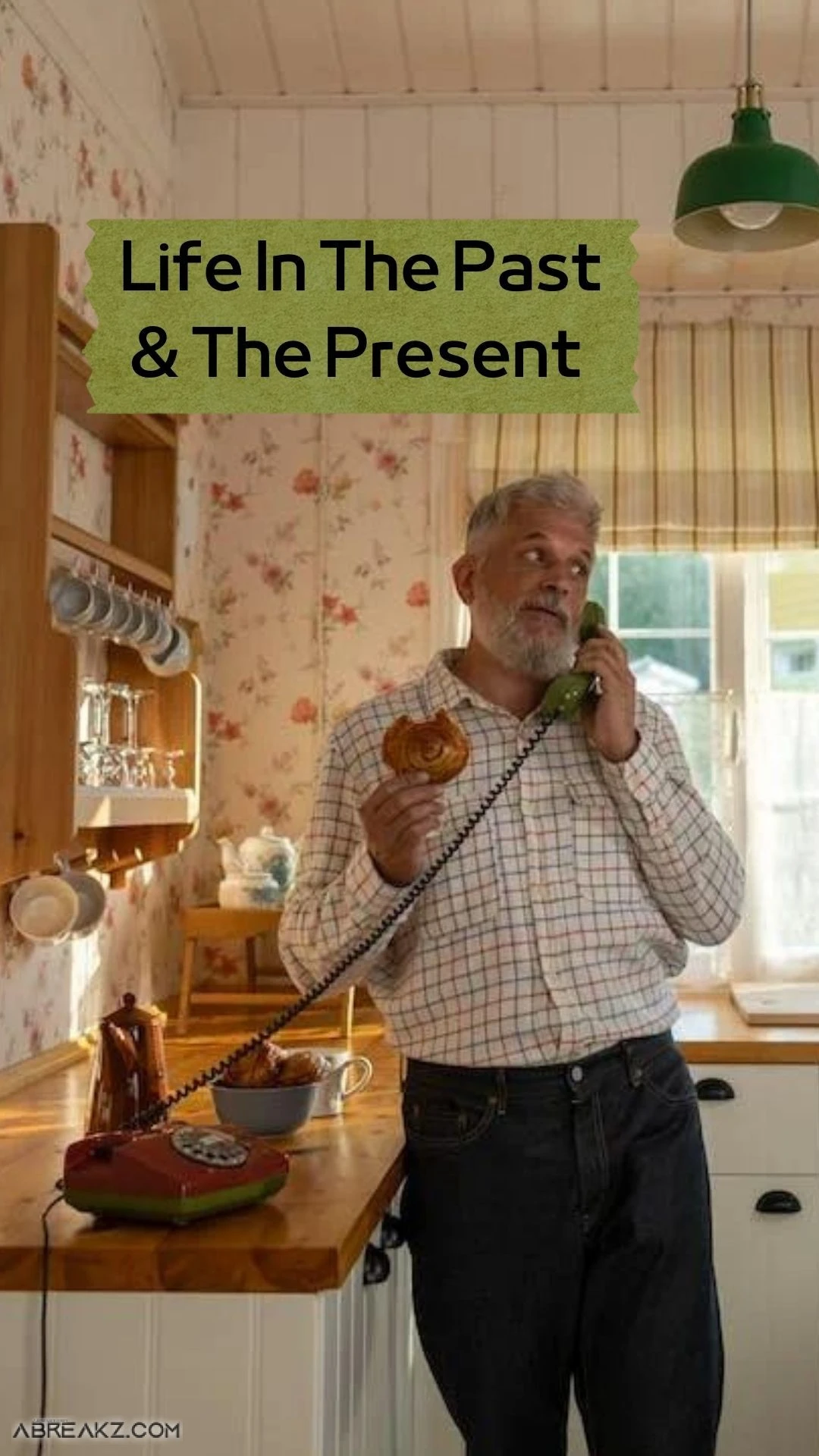
Difference Between Life In The Past and Present 7 Things Was Life In The Past Better Than Today
Home » Self Improvement » Difference Between Life In The Past and Present 7 Things Was Life In The Past Better Than Today
Life In The Past and The Present
What are essential differences between life in the past and present.
There are fundamental differences between the past and the present, where life in the past was characterized by simplicity and easy life, and this is not available in the prepared technological life we live now, but there are great differences in terms of machines and tools under which we live now, so what are these essential differences? This is what we learn through the following points:
The difference between dwellings between the past and the present The dwellings in the past were completely different from the present, while we now live in high-rise towers, and modern dwellings. In the distant and even recent past, dwellings were built with mud, wood, mud bricks and other construction tools, and then the matter has now evolved into building with reinforced iron, cement and other modern construction tools.

Clothes Between The Past And The Present
It is one of the most distinguishing features of the present and the past through clothing that is completely different in terms of shape and form, as there are now many types of different modern clothes that indicate human development, while clothes differed in the past in terms of design, fabrics and other aspects in which clothes are made.
Education Between Past And The Present
The difference between life in the past and now There is a great difference between educational means between the past and the present, where education was limited to men in most countries and was dependent on religious educational institutions and not official government, but now women crowd out men in education, in addition to the difference and development of educational means until we reached distance education via distance learning. way of internet sites life in the past and now essay.
You Can Read : passion in life
Mars Life In The Past
Transportation and transportation and the difference between the past and the present
The means of transportation and transportation in the past depended on animals, horses and camels, which moved to more sophisticated transportation such as trains, cars, planes and many other transportations that we use in our daily lives.
Past lifestyle was based on agriculture.
Difference Between Past and Present Lifestyles in terms of Economy
Past: With the Agriculture based economy, people bartered goods.
Present: We are today moving towards an industrial economy which is cooperating with the service sector; as a survival factor agriculture keeps these two sectors running in a successful way by giving the needed supply for their daily demand on food consumption.

life in the past and present
Difference between past and present lifestyles and clothing.
Past: In the past , people used to wear simple clothes made out of dry leaves; later, they slowly moved into different types of clothing. With the industrial revolution, this situation changed. People who had to work in industries had to cover themselves up in order to make sure they didn’t get exposed to the chemicals or any other harmful things. Therefore, long dresses, full body covered clothes came into the society. Later clothing changed in terms of the place you lived, your culture, ethnicity, and religion. For example, Indians used to cover themselves up with salwar, sarees, etc. whereas the western Europe people tend to cover themselves up according to the climate; shorts in warm areas and jeans in cold regions.
Important Aspects About The Difference Between Life In The Past And The Present.

Past: In the past, people wore simple clothes made of dry leaves; Later, they slowly moved to different types of clothing.
With the Industrial Revolution, this situation changed. People who had to work in industries had to cover themselves to make sure they were not exposed to chemicals or any other harmful things.
Therefore, long dresses, full-body covered clothes came into the community.
Clothes later changed in terms of where you lived, your culture, your race, and your religion. For example, Indians used to cover themselves with salwars, sarees, etc., while Western Europeans tended to cover themselves according to the climate; And pants in warm areas and jeans in cold areas.
Present: Aspects such as comfort, trend, and style are what matters in clothing rather than the climate or region in which you live.
For example, Indians wear their traditional clothing on occasions, but it is more in Western fashions such as jeans, pants, blouses, and shirts.

Difference Between Past And Present Lifestyles In Terms Of Education
Past: In terms of education in the past, people rarely got the opportunity to educate themselves.
The farmers made sure that their children knew how to draw a farm and carry out their daily chores. But with the passage of time, people went to religious institutes like church, temple, kovil and mosque in order to learn.
Later with the industrial revolution, factories and equipment came into effect, even the children of farming families were sent to the city to learn how to work with machines.
Then later with colonialism, people started learning languages and sciences as knowledge improved.
The most important fact is that all these changes in education took place only in the lives of the males as females were kept at home to do the daily work like sweeping, sewing, drawing, embroidery, cleaning and looking after the children.

These battles were granted freedom after many struggles. Today, women have the opportunity to obtain a quality education despite their religion, race, and ethnicity.
You Can Read : Educational Leadership
People now have access to books, magazines, and the Internet and students have made great progress in terms of education and access to knowledge.
However, as mentioned at the beginning, there are exceptions to these facilities.

Past and present lifestyles in the use of equipment and machinery
Past: In the past, our ancestors used small tools made of animal bones or wood. Animals were also used for plowing, carrying loads, etc.
Present: With the development, people began to use metals to make equipment such as knives, and other tools. Now, equipment is made of several materials such as carbon, fibre, and especially plastic to make things used for everyday use.
Today we use machines to do the same things with minimal effort and time. Machines have made life easier on Earth in terms of efficiency.
However, weapons can be described as a negative result of equipment development.
You Can Read : i love you so much

Lifestyles in terms of transportation Animals vs. Vehicles
Past: In the past, people used animals such as horses, donkeys and camels to travel from one place to another.
Similarities between life in the past and now
Present: With advances in technology, transportation has become much wider, easier and faster. There are a variety of vehicles to travel on land, air and water.
Speaking of transportation on water, during ancient times, ship travel took a long time, and many people died due to the bad weather and conditions of the ships.
But today, there are luxury cruisers that carry supermarkets, tennis courts, swimming pools, homes, etc.
Many people use planes to travel between countries.
Fresh Articles
- HostGator Hosting New Review 2024: Is It Right for Your Site? October 20, 2023
- New 4 Ways To Create Easily Professional Blog “Useful Information” October 20, 2023
- Easiest 6 Programming Language For Beginners September 5, 2023
- Tips To Help Maintain Self-Discipline During Work Pressure September 5, 2023
- Ways For Teachers To Benefit From ChatGPT In School September 5, 2023
- Sun Now Is Most Active In More Than 20 Years August 15, 2023
- A Self-made Billionaire Reveals AI Tricks To Get Rich Quickly August 15, 2023
- What the five hour rule is? How it works? Why you should use it? August 1, 2023
- The Reading| About It’s Most Prominent Features & What Should You Read? August 1, 2023
- How to buy cryptocurrency with huntington online Bank? July 13, 2023
- Best 5 Outsource web development services For Your Business July 13, 2023
- How ChatGPT Can Further Improve Your Productivity >Here It’s Some Ways? July 12, 2023
- Leadership Philosophy > Its types And Importance To Your Company3 July 6, 2023
- What Is Charisma >How To Be More Attractive 2024? July 6, 2023
- How To Balance Personal Life And Work? Here It’s Some Ways7 June 16, 2023
- 10 Emirati Universities Qualify For The British Times Rankings For 2023 June 16, 2023
Previous Post Can You Keep Your Calm With That Provocation & Naivety In These Situations?
Next post photoshop today plays on "ai" & neural filters to adjust age, about neural filter 2023 silky smooth, you may also like, tips to help maintain self-discipline during work pressure, what the five hour rule is how it works why you should use it, the reading| about it’s most prominent features & what should you read, leave a reply.
Save my name, email, and website in this browser for the next time I comment.
O2Break© - Take A Deep Breath, All Rights 2023-2024 Reserved To O2Break Inc.
Home — Essay Samples — Psychology — Childhood — Childhood Experiences: The Differences of Then and Now
Childhood then Vs Now: Differences and Similarities
- Categories: Childhood Childhood Development Childhood Experience
About this sample

Words: 1304 |
Published: Apr 8, 2022
Words: 1304 | Pages: 3 | 7 min read
Works Cited
- Boyd, D. (2014). It's complicated: The social lives of networked teens. Yale University Press.
- Cashmore, E. (2013). Childhood as spectacle: Relays of cultural meaning and the construction of children's identities. In T. Skelton, B. Valentine, & S. Chambers (Eds.), The Routledge Handbook of Cultural Geography (pp. 382-394). Routledge.
- Gardner, H. (2011). The unschooled mind: How children think and how schools should teach. Basic Books.
- Gee, J. P. (2012). Social linguistics and literacies: Ideology in discourses (4th ed.). Routledge.
- Ito, M., Baumer, S., Bittanti, M., Boyd, D., Cody, R., Herr-Stephenson, B., ... & Tripp, L. (2010). Hanging out, messing around, and geeking out: Kids living and learning with new media. MIT Press.
- Livingstone, S. (2018). Children and young people in a changing media environment. In The Routledge Handbook of Children, Adolescents and Media (pp. 1-16). Routledge.
- McFarland, D. A., & Pals, H. M. (2005). Motivation and social movements : The role of proximity and distance in framing the mobilization of 1968. American Sociological Review, 70(1), 65-85.
- Turkle, S. (2015). Reclaiming conversation: The power of talk in a digital age. Penguin Books.
- Twenge, J. M. (2017). iGen: Why today's super-connected kids are growing up less rebellious, more tolerant, less happy--and completely unprepared for adulthood--and what that means for the rest of us. Atria Books.
- White, M. (2013). The rise of the children's culture wars: Why 1990s youth and young adult fiction matters to the modern world. Scarecrow Press.

Cite this Essay
Let us write you an essay from scratch
- 450+ experts on 30 subjects ready to help
- Custom essay delivered in as few as 3 hours
Get high-quality help

Dr. Heisenberg
Verified writer
- Expert in: Psychology Philosophy

+ 120 experts online
By clicking “Check Writers’ Offers”, you agree to our terms of service and privacy policy . We’ll occasionally send you promo and account related email
No need to pay just yet!
Related Essays
2 pages / 715 words
2 pages / 820 words
5 pages / 2179 words
1 pages / 369 words
Remember! This is just a sample.
You can get your custom paper by one of our expert writers.
121 writers online
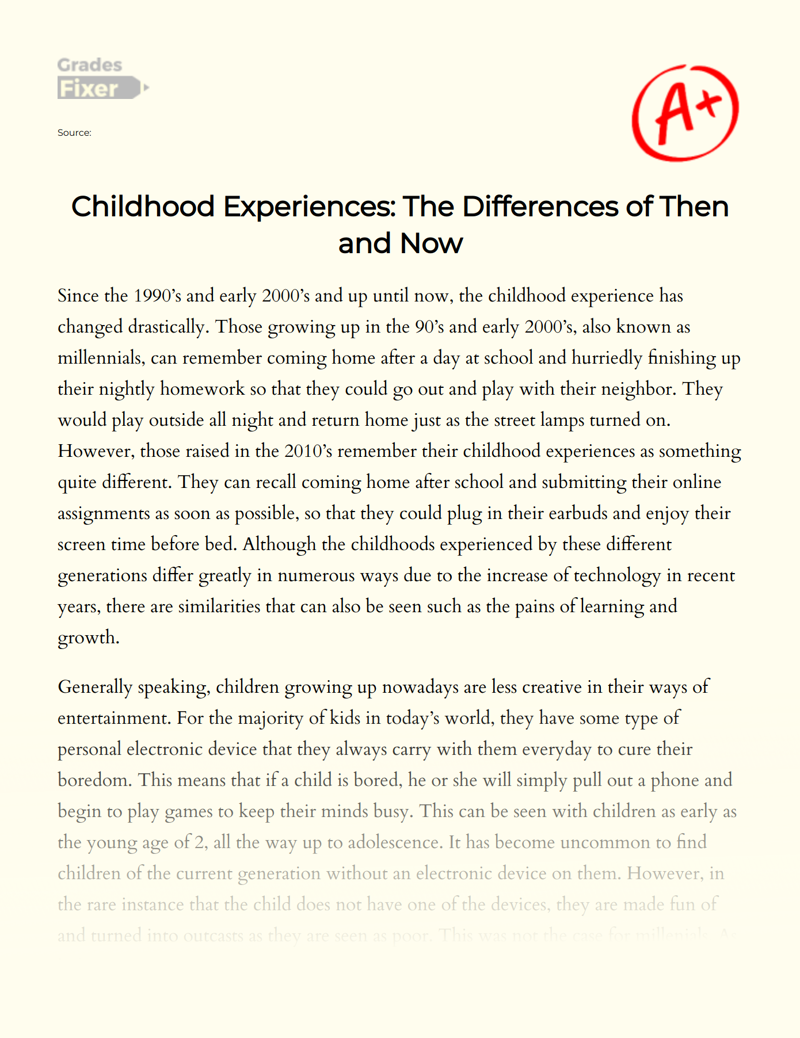
Still can’t find what you need?
Browse our vast selection of original essay samples, each expertly formatted and styled
Related Essays on Childhood
Dissociative Identity Disorder (DID), characterized by the presence of two or more distinct identities or personality states within an individual, remains a complex and often misunderstood mental health condition. Notably [...]
In Harper Lee's classic novel "To Kill a Mockingbird," the symbol of innocence holds a prominent place, shedding light on the moral and social complexities of the time. In today's world, the theme of innocence continues to [...]
CIPD. 'Survey Report: Good Work Index 2019-2020.' Chartered Institute of Personnel and Development.
Childhood is a crucial period in an individual's life that shapes their future development and well-being. However, in today's modern culture, there are growing concerns that childhood is being negatively impacted by various [...]
As a child, teen, and adult we go through many stages of changes and developments from our physical stature to our emotional stages. Even the way we think can sometimes go from wanting to be an artist when we grow up to wanting [...]
Are the childhoods that society reads about in popular works of literature accurate representations of how children lived throughout history, or are the authors of these texts portraying the personalities of their characters in [...]
Related Topics
By clicking “Send”, you agree to our Terms of service and Privacy statement . We will occasionally send you account related emails.
Where do you want us to send this sample?
By clicking “Continue”, you agree to our terms of service and privacy policy.
Be careful. This essay is not unique
This essay was donated by a student and is likely to have been used and submitted before
Download this Sample
Free samples may contain mistakes and not unique parts
Sorry, we could not paraphrase this essay. Our professional writers can rewrite it and get you a unique paper.
Please check your inbox.
We can write you a custom essay that will follow your exact instructions and meet the deadlines. Let's fix your grades together!
Get Your Personalized Essay in 3 Hours or Less!
We use cookies to personalyze your web-site experience. By continuing we’ll assume you board with our cookie policy .
- Instructions Followed To The Letter
- Deadlines Met At Every Stage
- Unique And Plagiarism Free
- Listening Tests
- Academic Tests
- General Tests
- IELTS Writing Checker
- IELTS Writing Samples
- Speaking Club
- IELTS AI Speaking Test Simulator
- Latest Topics
- Vocabularying
- 2024 © IELTS 69
Life in the past and now. When it was better?
IELTS essay Life in the past and now. When it was better?
- Structure your answers in logical paragraphs
- ? One main idea per paragraph
- Include an introduction and conclusion
- Support main points with an explanation and then an example
- Use cohesive linking words accurately and appropriately
- Vary your linking phrases using synonyms
- Try to vary your vocabulary using accurate synonyms
- Use less common question specific words that accurately convey meaning
- Check your work for spelling and word formation mistakes
- Use a variety of complex and simple sentences
- Check your writing for errors
- Answer all parts of the question
- ? Present relevant ideas
- Fully explain these ideas
- Support ideas with relevant, specific examples
- ? Currently is not available
- Meet the criteria
- Doesn't meet the criteria
- 6 band Life now and in the past. When was it better? There is no doubt, that word has changed a lot for the recent 40 years. That’s why the older generation tends to claim that they used to live better than now. In this essay I try to suppose why they consider like that and give you my point of view. As for me, I am convinced that this opinion of some ...
- 7 band deforestation What are the primary causes of deforestation? to what results may it lead. Nature provides us with fresh air and aids in maintaining harmony of the environment, however, in the recent years chopping of plantation has resulted in harmful effects on our habitat. There are various reasons that are causing explanation which ultimately leads to extinction, which I will discuss ...
- Learn a language, and you’ll avoid a war. Arab Proverb
- 5.5 band Global interdepence and its affects on the economy Recently, The world has been more globalized than ever, which has been significantly beneficial for the global economy. However, some people still argue that globalization is a negative development, and that the world was better off when countries didn’t interdepend on each other. So, was globalizat ...
- 5.5 band Globnal interdepence and the things it brought forth Recently, The world has been more globalized than ever, which has been significantly beneficial for the global economy. However, some people still argue that globalization is a negative development, and that we were better off when countries didn’t inter dependon each other. So, was globalization a ...
- If you talk to a man in a language he understands, that goes to his head. If you talk to him in his own language, that goes to his heart. Nelson Mandela
- 5.5 band Animal rights and animal explotitons. Animals should not be exploited by people and they should have the same rights as humans. They have their own rights and people should respect that. Today animal rights are better than past. Nowadays, most people respect animal rights and activists defend animal rights. Despite this, some people do ...
- 6 band discus both views and giving opinion There is no doubt that at some period of humans's lives there is the happiest moment even though it depens from one to another which is a conflict point. Some people believe that the chilhood is the best time while others admit that hapiness came when they became matures. However, I think that the g ...
- Language is not a genetic gift, it is a social gift. Learning a new language is becoming a member of the club – the community of speakers of that language. Frank Smith
- Call us Topics in English
- Privacy Policy
- terms of use
Topics in English Topics in english to learn and fluent pronunciation and writing and facilitate conversation between you and others, whether in school, work or daily life

Essay about Kuwait 12 models
Last updated Saturday , 16-03-2024 on 10:39 am
Essay about Kuwait , contains all the important and valuable information about Kuwait in terms of location, economy and all the information you are looking for about Kuwait will be found here under the title “Essay about Kuwait”.
Essay about Kuwait
Kuwait is one of the most beautiful Arab cities and here you will find an essay about Kuwait contains all the information you are looking for to know more about Kuwait.
Kuwait is the third smallest country in the Arabian Gulf. It is one of the countries of the Middle East. It is located in the southwest of Asia. Its capital is Kuwait City.
Kuwait is a hereditary emirate governed by the Al-Sabah family. It has a democratic constitutional monarchy, and Kuwait is a member of the Gulf Cooperation Council. Islam is the religion of the state, and Arabic is the official language of the state.
Kuwait overlooks the Arabian Gulf from the east, with the Republic of Iraq to the north and west, and Saudi Arabia to the south.
It has an area of 17,000, eight hundred and eighteen square kilometers, with approximately four million inhabitants. Kuwait has many islands but is uninhabited.
Most of these islands belong to the capital city, we will address some of them:
Boubyan Island : It is the largest Kuwaiti island and is considered a protected area.
Failaka Island : The only island inhabited by Kuwaitis, but abandoned by the Iraqi invasion of Kuwait.
Werba Island : A large number of seagulls and bouncy fish, which are good islands for birds and marine organisms.
The island of Kubr : This island is rich in coral reefs, so it is one of the most beautiful islands in Kuwait, a sandy island, characterized by its calm water.
Aouha Island : On this island, the grouper has a large population, so it is considered one of the best islands for fishing.
Umm Al-Maradim Island : This island is home to the Nawras and Al-Bashrush Islands, which are famous islands of pearls.
The State of Kuwait has six governorates: Jahra Governorate, the largest of which is Al-Farwaniya Governorate, Al-Farwaniya Governorate, and Al-Farwaniya Governorate, Mubarak al-Kabeer Governorate and Ahmadi Governorate.
Pearl diving, maritime trade and shipbuilding are among the most important occupations Kuwaitis have been working in since the founding of the State of Kuwait and before the discovery of oil to earn a living, making it the most important commercial center in the Arabian Gulf and its ports from major ports in the Arabian Peninsula and Mesopotamia.
Kuwait has become one of the richest countries in the world economically. It has the fifth largest oil reserves in the world and the official currency is the Kuwaiti Dinar since it was officially adopted in 1960. The Kuwaiti dinar is one of the highest exchange rates in the world compared to the US dollar.
A piece about Kuwait today
Kuwait today is one of the world’s largest per capita income countries. This is due to several reasons, the most important of which is the small geographical area and the little number of of its people.
Petroleum is one of the most important means of income to it. Besides the current investment made by businessmen and outside investors. Which makes it a great destination for many newcomers seeking employment opportunities in it.
Kuwait, compared to the other Arab kingdoms, is the most open in the political aspect. But it is one of the most conservative of them. Its people are very proud of the ancient heritage and civilization on which the State of Kuwait was founded.
Many of them still adhere to old customs and traditions despite the powers and recent decisions made by the state in 2006, such as enabling women to vote, or the possibility of obtaining a passport without the consent of the husband.
We find that the people of Kuwait, despite their prosperity and prosperous economic progress, still adhere to the ancient Bedouin side on which they grew up.
Kuwait importance Essay
The picturesque Kuwait is the endeavor of many politicians and merchants to establish commercial relations or an economic and political alliance.
This is due to the fact that the State of Kuwait represents an important oil supplier to all countries of the world. Especially in Europe, and it is natural that there is a great prosperity internally in the State of Kuwait, behind oil revenues.
Therefore, we find that the cultural aesthetic aspect is abundant everywhere in it. Where it is attracted to its civilized features, on a daily basis, tourism thirsty to see it or investors.
One of the best places that I like to visit is the Fountain Garden, which is located in the center of the capital in the Salmiya neighborhood. Where the giant garden includes places to sit and games for young children.
But what I like most about it is the diverse presence of people from different countries enjoying the music and the beautiful scenery. And they enjoy, however, eating from its restaurants. They can also enjoy the green spaces found everywhere.
I also like a lot of other areas, such as the Tariq Rajab Museum, Aqua Park Kuwait, Souk Al Mubarakiya, and House of Mirrors . And many other picturesque areas to spend time in.
Paragraph about Kuwait
Kuwait is characterized by an important geographical location. It is located in western Asia, bordered to the east by the Arabian Gulf, to the north and west by the Republic of Iraq, while to the south by the Kingdom of Saudi Arabia. The area of Kuwait is 17,818 square kilometers.
Kuwait is an important Arab country in the Middle East, and it has An effective role in solving the problems of the Middle East region. Kuwait is also considered the richest country because of its reserves of oil.
Kuwait was founded in 1613 AD, and the Al-Sabah family took over the rule. The official language in the State of Kuwait is Arabic, and the Islamic religion is the official religion of the state.
Life in Kuwait in the past essay
In the past, life in Kuwait was very simple, dominated by authentic Arab customs and traditions, such as generosity. Honoring the guest is one of the indigenous traditions of the Arabs, in addition to the fact that the Islamic religion urges honoring and welcoming the guest and smiling in his face.
As life in Kuwait was characterized by strong interdependence between families. Families used to gather together on all occasions. Even during the war with Iraq and all the sabotage operations that took place, Kuwait maintained its customs and traditions.
Certainly, after the end of the war, Kuwait closed in a little on itself, and lost confidence in some other countries. Which made her work on internal development on her own without any assistance, which prolonged her recovery period.
I find Kuwait now more developed than before, and its relations with other countries have become more open. I like what Kuwait has achieved, and I wish the best for it always.
Life in Kuwait in the past and nowadays ess
My name is (..). I live in Kuwait with my mum, dad and younger brother. I study in class (..). I am (..) years old. I love very much life in Kuwait.
My father and grandfather always tell me about Kuwait in the past. I can describe old Kuwait through their talk to me. And modern Kuwait, I can describe it because I see it and I am experiencing it now.
Kuwait in the past was a source of attraction for all foreign expatriates. It was a state of opportunities and dreams for many other nationalities. The old Kuwait was less open and more adherent to customs and traditions. It maintained the Bedouin side despite the availability of a strong economy.
My grandfather tells me that one of the pioneering business at the time was collecting some herbs and selling them in the city. My father told me that when he was young he worked in casting and repairing keys. And that his brother was working in collecting dates and separating nuclei. There were lots of simple trades.
But now Kuwait is very different, as there are large businesses, factories and companies. The Kuwaiti citizen no longer works in handicrafts. Education helped improve these opportunities and enable the Kuwaiti citizen to manage trade or employment in prestigious places.
Due to the availability of a strong economy and a great attraction for tourism, there are many profitable private trades that do not require handicrafts for the Kuwaiti citizen. This is the difference that I see in Kuwait, old and new.
Kuwait in the past and present essay
Kuwait, like many ancient and modern Arab countries, the origins of the tribes that lived in the ancient era of Kuwait are Bedouin.
Their dependence was on breeding sheep and camels. There are those who collect medicinal herbs and sell them in the market. There are some who work in the fishing industry.
This continued for a long time in Kuwait, and it was one of the countries with generosity, customs and tradition. Where its people adhere to the original Arab customs and traditions.
But in 1934 the Kuwait Oil Company Limited was established to completely change Kuwait’s perspective and enter the race for development and improvement.
One of the crucial years in the history of Kuwait was the year 1938, when the first oil field was discovered in Kuwait. It was named Burgan field.
Since then, Kuwait has been in permanent prosperity, development and improvement in all means of living and health. Where the Kuwaiti currency represents one of the most expensive currencies in our modern time.
Annual oil revenues reached 60 billion dollars. Which made a large surplus in its treasuries and a large capacity for construction, development and reconstruction.
Essay about Kuwait in the past and present
Kuwait in ancient times before 1934 was less civilized than other Arab countries, due to the limited geographical area, and also due to the lack of natural resources available to it.
The main dependence was on fisheries or raising camels and sheep, or on collecting the natural herbs found in the deserts.
The first real development of Kuwait was at the beginning of 1934. Where the first oil field was discovered. To be the first source of real and radical change in the history of Kuwait and its people.
After that, many fields flowed and a significant improvement in the level of national income through oil happened. Which provided an opportunity for the state to advance and progress and made it an important destination for expatriates seeking work.
Today, Kuwait has become one of the world’s most important oil exporters, with annual revenue reaching $60 billion. The Kuwaiti currency is one of the most expensive currencies in the world.
Kuwait became in the 21st century a pioneer in industry, commerce, tourism and business. It has become more advanced than many Arab countries that were once overpowering it. Not only that, but also more advanced than many foreign countries as well.
Paragraph about life in old Kuwait
Kuwait represents the ancient civilization. Kuwait is famous for being from Arab tribal descent. These tribes were more closely related to each other. There is a lot of love and closeness in it, and everyone was working to improve the state and striving for it.
Old Kuwait was famous for its generosity and hospitality. This is what made the foundation stone on which we live today is solid and strong.
Because of the adherence of the people of Kuwait to the customs and values of the past, new generations have appreciated this and preserve the original Kuwaiti heritage.
Paragraph about life in the past in Kuwait
Kuwait was not in great prosperity and progress in the past, due to several obvious reasons, including the geographical size, as well as the lack of multiple natural resources.
Therefore, life in Kuwait in the past was less simple than what we live today, and transportation was by completely different means, and many of the people lived the traditional Bedouin life.
But that changed with Kuwait’s progress in ambition and striving for advancement and progress. In 1943, the first oil field was discovered in Kuwait
Hence, the state began to work on improvement and development and try to build a sound system that would help the state in its advancement.
Then came the independence of Kuwait in 1961. After that, Kuwait rose in the cultural and scientific aspect, and the Bedouin tribal landmarks changed from that time to become Kuwait more glamorous and advanced at the present time.
Paragraph about Kuwait in the past and nowadays
Kuwait before the declaration of independence was more simple in terms of the living and educational life of the individual. This is due to the fact that the origins of the tribes living in Kuwait are Bedouin. Which imposed a simple life.
But that certainly changed completely after the first oil field was found and Kuwait declared its independence. There has become more development in social, cultural and health life.
All the people of Kuwait now live in luxurious homes and the markets are more developed. And the means of transportation were loaned to become the best in the world.
Infrastructure has been improved. Which contributed to the prosperity of trade and attracting foreign investors to work in the State of Kuwait.
Comparing life in Kuwait in the past and nowadays
Kuwait, like many Arab countries, its beginning was tribal living in tents. It is distinguished by its adherence to tribal customs and its good generosity and hospitality.
The emergence of Kuwait in the past was difficult, as it faced many challenges before finding oil fields. Even after finding the oil fields and declaring the independence of Kuwait, life was not always easy, as the conflict with one of the Arab countries, Iraq, came after that.
Which caused great damage to the oil fields, which led to many losses. But it is good that everyone participate to rebuild Kuwait again to rise and become more glamorous. We can see Kuwait today, and the level of social and educational progress.
We can see the brilliance of Kuwait in everything surrounding us from health services, educational services, providing suitable job opportunities for the Kuwaiti citizen that preserves his dignity and prestige and wide interest in recreational services available everywhere.
Certainly, the continuous work on expansion and improvement of the infrastructure is very important to accommodate the continuous expansion and permanent development.
I appreciate all the difficulties that Kuwait has gone through, and I can say that they were one of the reasons that made Kuwait stronger than before. It showed cohesion, solidarity and love for the country. Without solidarity to build a great country, the renaissance of Kuwait would not have taken place.
In this way we have provided you with an essay about Kuwait , and you can read more of the topics through the following section:
- Essay on Kuwait
Related Articles

Value of Time Essay 3 Models
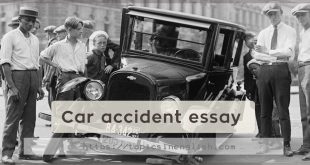
Car accident essay 6 models
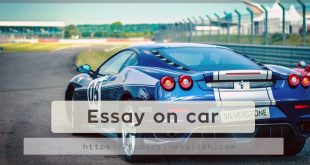
Essay on car 10 models
Leave a reply cancel reply.
Your email address will not be published. Required fields are marked *
- Share full article
Advertisement
Supported by
Guest Essay
The One Idea That Could Save American Democracy

By Astra Taylor and Leah Hunt-Hendrix
Ms. Taylor and Ms. Hunt-Hendrix are political organizers and the authors of the book “Solidarity: The Past, Present, and Future of a World-Changing Idea.”
These days, we often hear that democracy is on the ballot. And there’s a truth to that: Winning elections is critical, especially as liberal and progressive forces try to fend off radical right-wing movements. But the democratic crisis that our society faces will not be solved by voting alone. We need to do more than defeat Donald Trump and his allies — we need to make cultivating solidarity a national priority.
For years, solidarity’s strongest associations have been with the left and the labor movement — a term invoked at protests and on picket lines. But its roots are much deeper, and its potential implications far more profound, than we typically assume. Though we rarely speak about it as such, solidarity is a concept as fundamental to democracy as its better-known cousins: equality, freedom and justice. Solidarity is simultaneously a bond that holds society together and a force that propels it forward. After all, when people feel connected, they are more willing to work together, to share resources and to have one another’s backs. Solidarity weaves us into a larger and more resilient “we” through the precious and powerful sense that even though we are different, our lives and our fates are connected.
We have both spent years working as organizers and activists . If our experience has taught us anything, it is that a sense of connection and mutualism is rarely spontaneous. It must be nurtured and sustained. Without robust and effective organizations and institutions to cultivate and maintain solidarity, it weakens and democracy falters. We become more atomized and isolated, suspicious and susceptible to misinformation, more disengaged and cynical, and easily pitted against one another.
Democracy’s opponents know this. That’s why they invest huge amounts of energy and resources to sabotage transformative, democratic solidarity and to nurture exclusionary and reactionary forms of group identity. Enraged at a decade of social movements and the long-overdue revival of organized labor, right-wing strategists and their corporate backers have redoubled their efforts to divide and conquer the American public, inflaming group resentments in order to restore traditional social hierarchies and ensure that plutocrats maintain their hold on wealth and power. In white papers, stump speeches and podcasts, conservative ideologues have laid out their vision for capturing the state and using it as a tool to remake our country in their image.
If we do not prioritize solidarity, this dangerous and anti-democratic project will succeed. Far more than just a slogan or hashtag, solidarity can orient us toward a future worth fighting for, providing the basis of a credible and galvanizing plan for democratic renewal. Instead of the 20th-century ideal of a welfare state, we should try to imagine a solidarity state.
We urgently need a countervision of what government can and should be, and how public resources and infrastructure can be deployed to foster social connection and repair the social fabric so that democracy can have a chance not just to limp along, but to flourish. Solidarity, here, is both a goal worth reaching toward and the method of building the power to achieve it. It is both means and ends, the forging of social bonds so that we can become strong enough to shift policy together.
Historically, the question of solidarity has been raised during volatile junctures like the one we are living through. Contemporary conceptions of solidarity first took form after the democratic revolutions of the 18th century and over the course of the Industrial Revolution. As kings were deposed and the church’s role as a moral authority waned, philosophers and citizens wondered how society could cohere without a monarch or god. What could bind people in a secular, pluralistic age?
The 19th-century thinkers who began seriously contemplating and writing about the idea of solidarity often used the image of the human body, where different parts work in tandem. Most famously, the French sociologist Émile Durkheim put solidarity at the center of his inquiry, arguing that as society increased in complexity, social bonds between people would strengthen, each person playing a specialized role while connected to a larger whole. Solidarity and social cohesion, he argued, would be the natural result of increasing social and economic interdependence. But as Durkheim himself would eventually recognize, the industrial economy that he initially imagined would generate solidarity would actually serve to weaken its fragile ties, fostering what he called anomie, the corrosive hopelessness that accompanied growing inequality.
In the United States, solidarity never achieved the same intellectual cachet as in Europe. Since this nation’s founding, the concept has generally been neglected, and the practice actively suppressed and even criminalized. Attempts to forge cross-racial solidarity have met with violent suppression time and again, and labor organizing, effectively outlawed until the New Deal era, still occupies hostile legal ground. Decades of market-friendly policies, promoted by Republicans and Democrats alike, have undermined solidarity in ways both subtle and overt, from encouraging us to see ourselves as individual consumers rather than citizens to fostering individualism and competition over collectivity and cooperation.
As our profit-driven economy has made us more insecure and atomized — and more susceptible to authoritarian appeals — the far right has seized its opportunity. A furious backlash now rises to cut down the shoots of solidarity that sprung up as a result of recent movements pushing for economic, racial, environmental and gender justice. In response, programs that encourage diversity and inclusion are being targeted by billionaire investors, while small acts of solidarity — like helping someone get an abortion or bailing protesters out of jail — have been criminalized.
Awaiting the return of Mr. Trump, the Heritage Foundation has mapped out a plan to remake government and society, using the full power of the state to roll back what it calls “the Great Awokening” and restore a Judeo-Christian, capitalist “culture of life” and “blessedness.” “Woke” has been turned into a pejorative so that the word can be wielded to tarnish and break the solidarity that people have only just begun to experience.
Our vision of a solidarity state offers a pointed rejoinder to this project. Social democrats and socialists have been right to emphasize the need for redistribution and robust public investment in goods and services. We must restructure our economy so that it works for the many and not the few. But unlike conservatives — think, for example, of Margaret Thatcher, the prime minister of Britain who in 1981 said, “Economics are the method; the object is to change the heart and soul” — liberals and leftists have tended to downplay the role of policy in shaping public sensibilities. This is a mistake.
Laws and social programs not only shape material outcomes; they also shape us, informing public perceptions and preferences, and generating what scholars call policy feedback loops. There is no neutral state to aspire to. Policies can either foster solidarity and help repair the divides that separate us or deepen the fissures.
Today, the American welfare state too often does the latter. As sociologists including Suzanne Mettler and Matthew Desmond have detailed, lower-income people tend to be stigmatized for needing assistance, while more-affluent citizens reap a range of benefits that are comparatively invisible, mainly through tax credits and tax breaks. Both arrangements — the highly visible and stigmatized aid to the poor and the more invisible and socially acceptable aid to the affluent — serve to foster resentment and obscure how we are all dependent on the state in various ways.
Instead of treating citizens as passive and isolated recipients of services delivered from on high, a solidarity state would experiment with creative ways of fostering connection and participation at every opportunity for more Americans. What if we had basic guarantees that were universal rather than means-tested programs that distinguish between the deserving and undeserving, stigmatizing some and setting groups apart? What if, following the model of a widely admired program in Canada, the government aided groups of private citizens who want to sponsor and subsidize migrants and refugees? What if public schools, post offices, transit systems, parks, public utilities and jobs programs were explicitly designed to facilitate social connection and solidarity in addition to providing essential support and services?
We’ll get there only if we take up the challenge of building solidarity from wherever we happen to sit. Both means and end, solidarity can be a source of power, built through the day-to-day work of organizing, and our shared purpose. Solidarity is the essential and too often missing ingredient of today’s most important political project: not just saving democracy but creating an egalitarian, multiracial society that can guarantee each of us a dignified life.
Astra Taylor and Leah Hunt-Hendrix are political organizers and the authors of the book “Solidarity: The Past, Present, and Future of a World-Changing Idea.”
The Times is committed to publishing a diversity of letters to the editor. We’d like to hear what you think about this or any of our articles. Here are some tips . And here’s our email: [email protected] .
Follow the New York Times Opinion section on Facebook , Instagram , TikTok , WhatsApp , X and Threads .
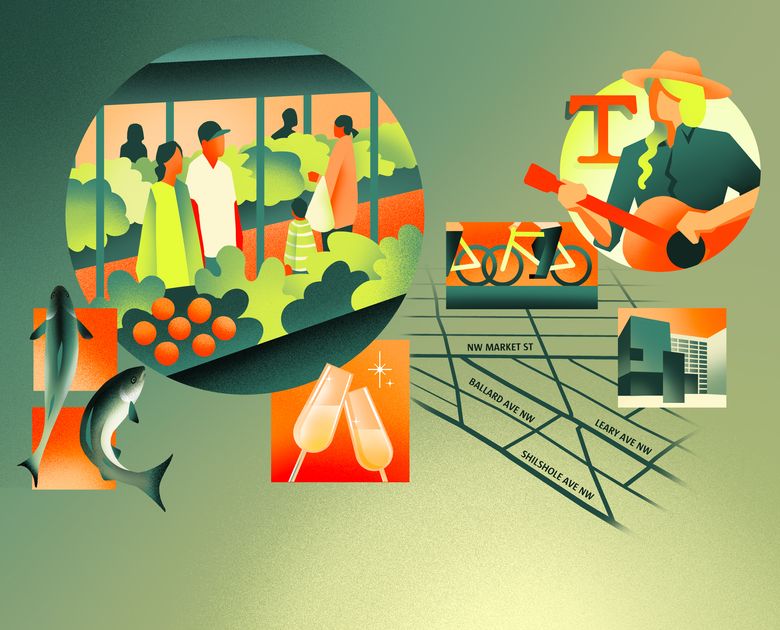
A deep dive into Ballard What makes the neighborhood special, from past to present
- Entertainment
- Food & Drink
Once known as a blue-collar, seafaring enclave, sometimes the target of teasing from other corners of Seattle, today’s Ballard looks quite different to those who grew up there. Now, trendy restaurants and quirky-but-pricey lifestyle stores are signature features of the neighborhood — though some of its most iconic spots, like the Ballard Locks , remain.
For our latest edition of This City Block, our writers explored the neighborhood’s past (from movie theaters to dive bars ) and its present (from the much-loved farmers market to locals’ favorite destinations ).
Here’s a look at the evolving neighborhood and how to spend some time there.
About the project: This City Block
Every single block in Seattle holds millions of stories — from the people who traverse and make homes on them, to the businesses that come and go from their storefronts over the years. Even the streetlights and graffiti, a broken link in the fence or an interesting mural might hold a story.
This City Block tells the story of our city — past, present and future — one neighborhood at a time.
Check out previous This City Block editions exploring:
- West Seattle Junction
- 23rd & Union
- Rainier Beach

Grungy yet gentrified: What makes Ballard an enigma in Seattle
Once a blue-collar, seafaring enclave, now trendy, Ballard is in many ways a reflection of how Seattle has evolved and the challenges it faces.
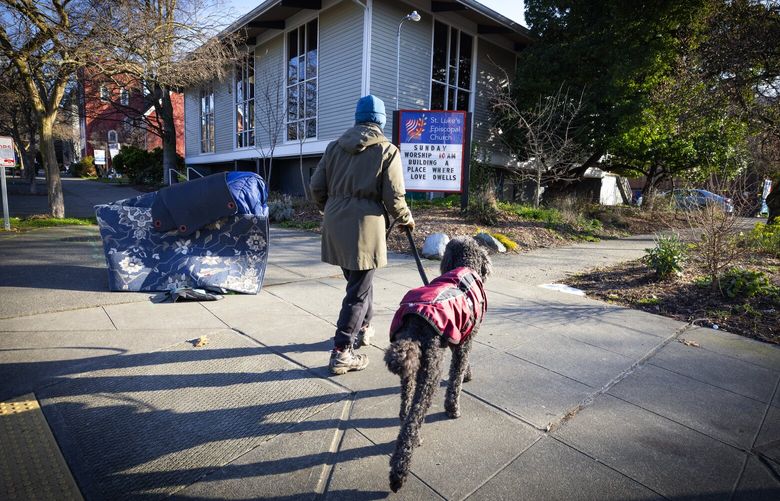
Why is there so much homelessness in wealthy Ballard?
Few Seattle neighborhoods with high incomes have as much of a visible homeless presence as Ballard. Its origins as a blue-collar town help explain why that is.

Is Ballard cool or kitsch? It depends on who you ask
You can still find vestiges of Ballard’s blue-collar past around. But its evolution is ongoing. What exactly does it mean to be “authentically” Ballard today?
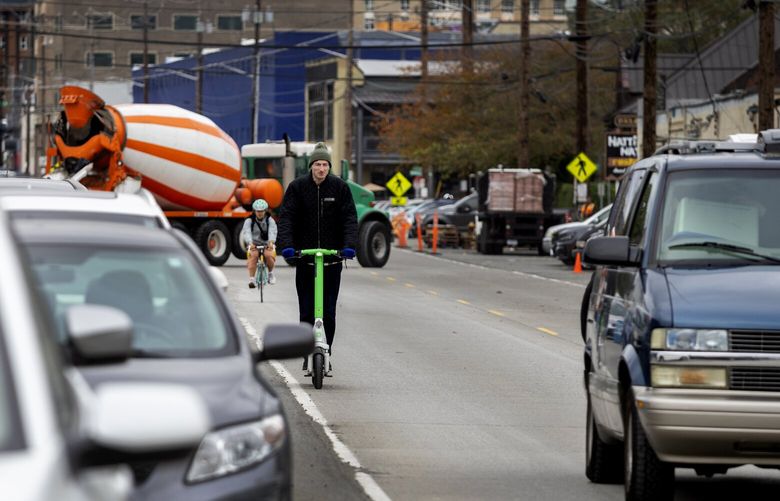
What’s new in the fight to fix the ‘missing link’ in the Burke-Gilman
For decades, a stretch of the Burke-Gilman Trail in Ballard has been incomplete. Tired of stalling, cyclists and Ballard leaders are looking for a new path ahead.
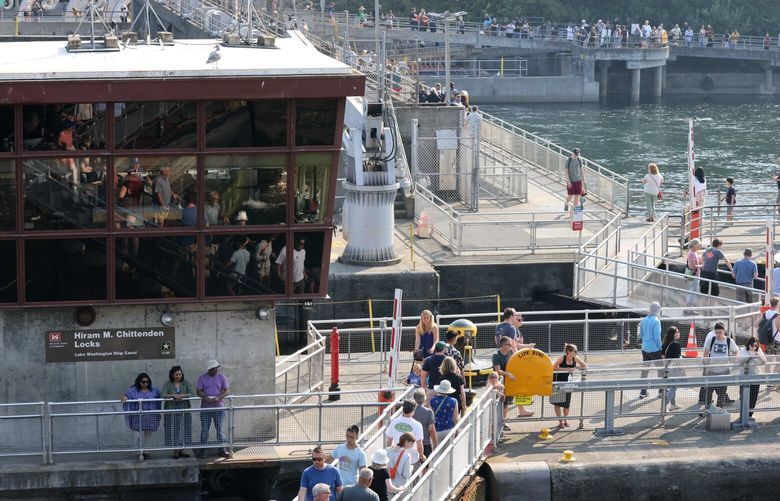
Welcome to old Ballard: Reader memories of a transformed neighborhood
Who better to talk about the transformation of a neighborhood than the people who lived the change? Ballardites and other Seattleites remember “old Ballard.”
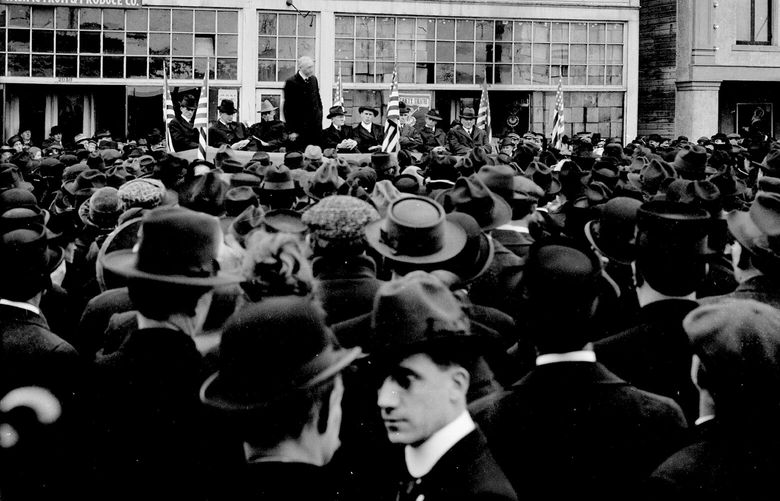
This Ballard street has delighted moviegoers for more than a century
Though now nearly a quarter-century old, the Majestic Bay movie theater still has a brand-new sparkle, but carries a sense of history.
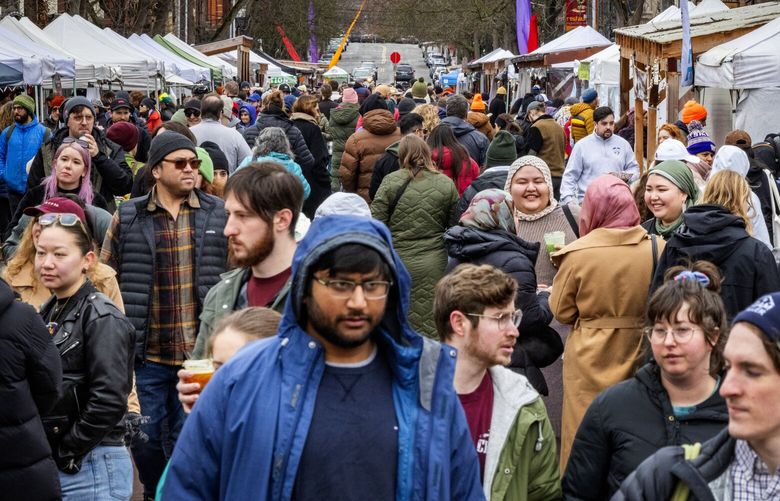
This Seattle farmers market is known as the city’s best
Since 2000, the Ballard Farmers Market has become a community hub where local farmers, crafters and vendors can connect face to face with their customers.
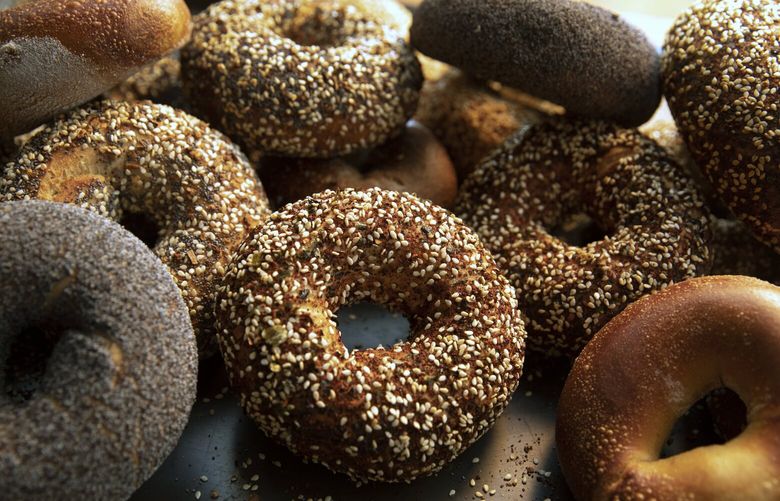
Tan Vinh’s top 11: Our food writer names his favorite Ballard spots
Too long of a waitlist at The Walrus and the Carpenter? Fret not: For the latest edition of This City Block, our food writer named his 11 favorite bars, restaurants and deals in Ballard.
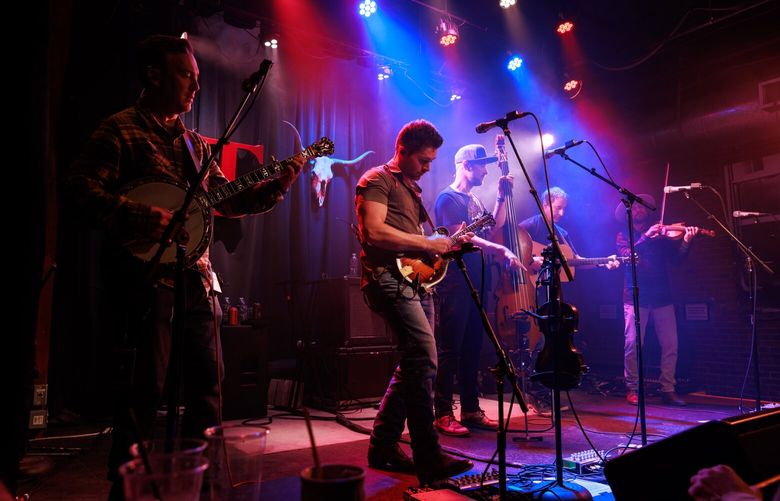
Tractor Tavern, home of the Ballard sound, preserves old-school spirit
The Ballard concert venue’s Americana sounds have become synonymous with the neighborhood.
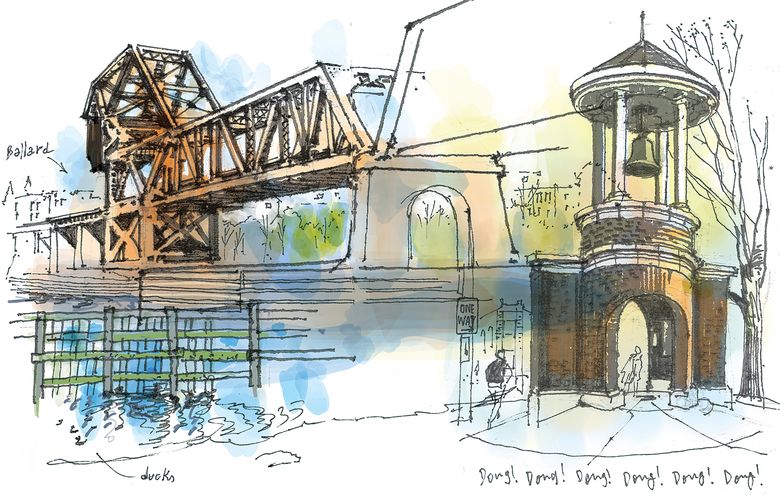
Ballard through the back door: An illustrated tour
Start at the edge of the Ballard Locks in Magnolia, wander through a garden and see an Indigenous sculpture and a giant troll en route to a bell tower.
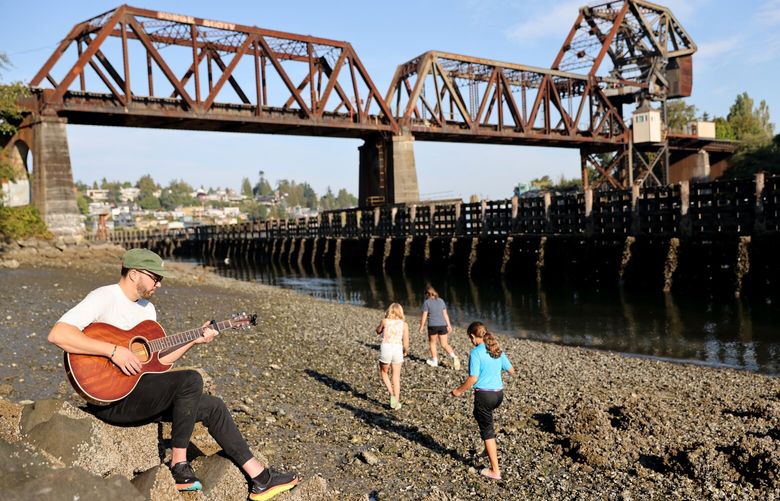
A hidden beach, one-stop Scandinavian shop and more recs from Ballard locals
Readers’ favorite destinations in the neighborhood are a mix of already popular but worth-the-hype destinations and lesser-known gems.
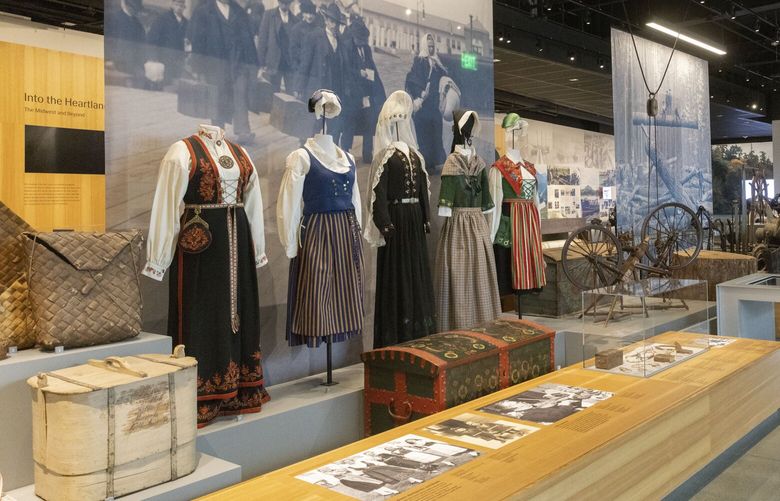
3 must-visit art and culture spaces in Ballard
Ballard is known for its hipster vibe and bustling restaurants, but it’s also home to a rich arts scene, and boasts the largest Nordic museum in the U.S.

Some of Seattle’s best-known writers have read at this Ballard literary group
At the It’s About Time Writers’ Reading Series, writers have been gathering to share their work with one another for 34 years.
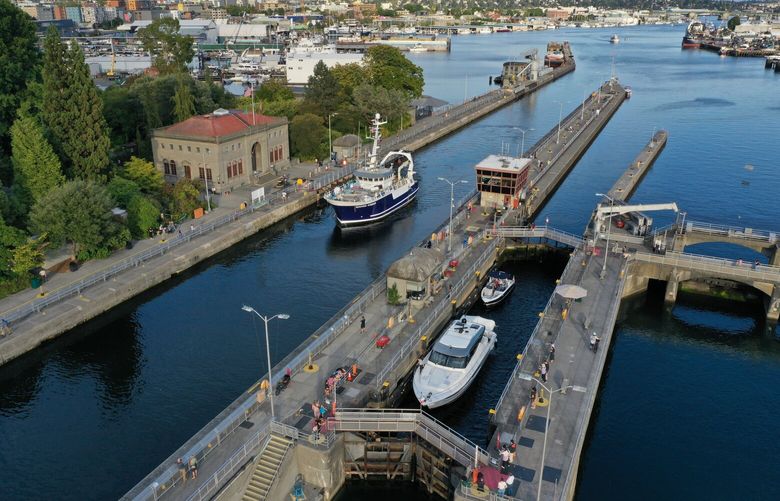
‘This is one of the most exciting times’ at Seattle’s busy, beloved Ballard Locks
A deep dive into the 106-year-old Locks, which profoundly shape Seattle’s landscape, economy and society — plus how the aged facility keeps on going.
Most Read Life Stories
- Unorthodox cooking method delivers lovely skillet broccoli spaghetti
- Mount Rainier July reservations for Sunrise, Paradise open Monday
- These 'Marry Me' white beans make for a quick, tasty snack
- How air travel has changed since the pandemic
- The next frontier of airport innovations is in the bathroom
The opinions expressed in reader comments are those of the author only and do not reflect the opinions of The Seattle Times.
Stay up to date with notifications from The Independent
Notifications can be managed in browser preferences.
UK Edition Change
- UK Politics
- News Videos
- Paris 2024 Olympics
- Rugby Union
- Sport Videos
- John Rentoul
- Mary Dejevsky
- Andrew Grice
- Sean O’Grady
- Photography
- Theatre & Dance
- Culture Videos
- Food & Drink
- Health & Families
- Royal Family
- Electric Vehicles
- Lifestyle Videos
- UK Hotel Reviews
- News & Advice
- Simon Calder
- Australia & New Zealand
- South America
- C. America & Caribbean
- Middle East
- Politics Explained
- News Analysis
- Today’s Edition
- Home & Garden
- Fashion & Beauty
- Travel & Outdoors
- Sports & Fitness
- Sustainable Living
- Climate Videos
- Behind The Headlines
- On The Ground
- Decomplicated
- You Ask The Questions
- Binge Watch
- Travel Smart
- Watch on your TV
- Crosswords & Puzzles
- Most Commented
- Newsletters
- Ask Me Anything
- Virtual Events
- Betting Sites
- Online Casinos
- Wine Offers
Thank you for registering
Please refresh the page or navigate to another page on the site to be automatically logged in Please refresh your browser to be logged in
April Fool’s Day 2024: The best jokes and pranks today
Which of these did you fall for, article bookmarked.
Find your bookmarks in your Independent Premium section, under my profile
Aldi's unveils haggis ice cream

Stay ahead of the trend in fashion and beyond with our free weekly Lifestyle Edit newsletter
Thanks for signing up to the lifestyle edit email.
Even though April Fools’ Day rolls around each year , there are always some unsuspecting people who fall for a gag or two.
From major corporations, brands, and even celebrities, everyone wants to be in on the fun, as they all try to outdo each other.
Some of the finest and most elaborate April Fool’s Day pranks from years past have entered into history at this point, such as the televised “spaghetti harvest” hoax .
Tricksters continue to keep up the ruse every year, with celebrities such as Ant and Dec getting in on the action for 1 April 2024.
Here is a roundup of the best pranks and gags from this year’s April Fool’s Day...
Krispy Kreme lets customers glaze anything… even a pizza
Krispy Kreme has a one day special offer inviting customers to come in and glaze anything they like – a slice of pizza, your cheeseburger, or even your morning oats.
Alison Hammond pranked on This Morning
Alison Hammond fell victim to an April Fools’ Day prank as she made her return to This Morning on Monday. Hammond and co-host Dermot O’Leary were interviewing a “guest” who apparently discovered her £1.50 vase was worth £30,000. Hijinks ensue.
Aldi’s unveils haggis ice cream
In a move that may potentially divide the nation, Aldi Scotland revealed a line of haggis-infused ice cream. Not for the faint of heart, obviously.
Dulux drops its new range of “scratch and sniff” paint
Dulux’s Easter-inspired range sounds almost too good to be true. The new revolutionary “Scratch & Sniff” collection features shades like Chocolate Sprinkles, Hazelnut Truffle, Cookie Dough, and Caramel Cream, and dries in only two hours. After that, scratch and sniff all you want!
As Dulux says: “Whether you’re redecorating your kitchen, bedroom, or even your bathroom, now every room can be a sensory spectacle.”
Sainsbury's drops new trolley
For everyone who likes to shop till they drop, Sainsbury has a solution. An obvious favourite, this one.
Ant and Dec announce hiatus
Ant and Dec have decided to announce an immediate hiatus to ply their trade somewhere else – the kitchen. Ant said: “I believe that food has the power to bring people together and create cherished memories, that’s how my family feel when I make them beans on toast. I am excited to embark on this culinary journey with my sous chef, Dec.”
Honda’s pet-activated wireless system
Honda’s Pet Activated Wireless System
Honda’s new “state-of-the-art, dog-first” technology, PAW-S, is a godsend for pet lovers. The new vehicle entry activation system supposedly allows your dog to access the car boot, and plenty of canine-friendly amenities, without any need for the owner to be around. Pooches can also use smart in-car technology to go for walks with their fellow four-legged friends.
Just stop oil announces their collaboration with Gorilla Glue
A partnership for the ages... or maybe just today. Climate protest activist group Just Stop Oil announced they had entered a partnership with American adhesive manufacturer Gorilla Glue. Mark Mercurio, president and chief executive officer of Gorilla Glue, said, “From glueing to roads or government departments, our incredibly strong range of polyurethane epoxies will keep environmental defenders in place for longer.”
Join our commenting forum
Join thought-provoking conversations, follow other Independent readers and see their replies
Subscribe to Independent Premium to bookmark this article
Want to bookmark your favourite articles and stories to read or reference later? Start your Independent Premium subscription today.
New to The Independent?
Or if you would prefer:
Want an ad-free experience?
Hi {{indy.fullName}}
- My Independent Premium
- Account details
- Help centre
BREAKING: Top Iranian military commander killed in Israeli airstrike on a consulate building, Tehran says
How Nicole Shanahan rose through tech and law to RFK Jr.'s ticket

Robert F. Kennedy Jr. has found an unlikely — but like-minded — running mate for his independent presidential ticket .
Tech lawyer Nicole Shanahan has no government experience and no national profile, and she is one of the most unusual selections for a high-profile running mate in recent memory. She is far less known than some of the other names Kennedy considered, including NFL star Aaron Rodgers and actor and former Minnesota Gov. Jesse Ventura.
But what she does offer is a similar worldview to Kennedy's, presumed loyalty to the person who plucked her from relative obscurity and — perhaps most important — enormous wealth that the Kennedy-Shanahan campaign could tap far in excess of contribution limits that would apply to donors who are not themselves candidates.
Shanahan, 38, also offers a youth and vitality that Kennedy often says is necessary in politics. And she has already demonstrated her commitment to Kennedy’s cause, revealing in February that she donated $4 million to a pro-Kennedy super PAC to help pay for a Super Bowl ad .
Despite mostly supporting progressive and center-left Democrats in the past, Shanahan has said that she was motivated to support Kennedy in part because of concerns about children’s health and the environment, including vaccines, and she has also expressed opposition to the research money that has poured into the in-vitro fertilization industry.

She defended Kennedy’s advocacy against vaccines to Newsweek this year, saying that “being called an anti-vaxxer is so unfair” and that “we need to have a safe space” to discuss the issue.
A life in the world's tech capital
Shanahan, a tech lawyer and entrepreneur turned philanthropist from Oakland, California, has lived a life that has intersected with some of the most important technologies and business titans in Silicon Valley.
Shanahan, born to parents who struggled financially, said that her family was on food stamps and that she started working at age 12 to help make ends meet.
“My dad was diagnosed with bipolar schizophrenia when I was 9, and my Chinese-born mom had only been in the United States for two years when I was born,” she told San Francisco magazine for a profile in 2021. “So not only was there no money, there was almost no parental guidance, and as you can imagine with a mentally ill father, there was lots of chaos and fear.”
She credits the internet with helping her escape, and technology would come to dominate her life after she graduated from the University of Puget Sound and returned to the Bay Area, attending Santa Clara University School of Law and then diving into the intersection of the legal and tech worlds.
In a landscape where innovation often outpaces regulation, she founded ClearAccessIP, a company that uses artificial intelligence technology to help patent holders manage their intellectual property, according to its website. The company was acquired by IPwe in 2020.
Shanahan married Google co-founder Sergey Brin in 2018 and divorced him in 2022. That year, The Wall Street Journal reported that she had an affair with billionaire Elon Musk, but both Shanahan and Musk have denied the accusation. The Journal has stood by its reporting.
“The WSJ’s narrative that an affair with Elon Musk led to the end of my marriage was about as accurate as claiming that the body heat of polar bears is responsible for the melting of the Arctic ice caps,” she wrote last year in a first-person essay for People. “It felt senseless and cruel.”
After the divorce from Brin, who is worth an estimated $121 billion, according to Forbes, she transitioned to full-time philanthropy work.
Shanahan’s charity, the Bia-Echo Foundation , says its mission is to “create a multiplying effect” on issues Shanahan cares about, including “reproductive longevity & equality, criminal justice reform and a healthy & livable planet.”
She started that work through her ex-husband’s foundation, announcing a $100 million commitment in 2019 to programs aimed at helping women become pregnant later in life, in addition to exploring solutions to criminal justice reform and climate change.
Fertility issues have been a focus of her foundation and her investment firm, Planeta Ventures, and a later gift of $6 million helped create the Center for Female Reproductive Longevity and Equality; she said her goal is to help women be able to have children into their mid-50s .
However, Shanahan has advocated against supporting IVF research, because, in her view, it detracts from understanding the root causes of infertility. And she has argued the procedure is “ sold irresponsibly ” and has become more of a “commercial endeavor” than a scientific one, calling its promise “one of the biggest lies that’s being told about women’s health today.”
“Many of the IVF clinics are financially incentivized to offer you egg freezing and IVF and not incentivized to offer you other fertility services,” Shanahan told The New Yorker last year.
“I’m so often told that IVF is this great technology, and I always get questioned why I’m not more supportive of IVF,” she said in an online video series . “I’ve tried to imagine where we would be as a field if all of the money that has been invested in IVF and all of the money that’s been invested into marketing IVF and all of the government money that has been invested in subsidizing IVF, if just 10% of that went into reproductive longevity, research and fundamental research.”
That view could be especially relevant this year as both parties debate abortion rights after the Supreme Court’s 2022 decision overturning Roe v. Wade. An Alabama Supreme Court ruling this year that frozen embryos created for IVF were people briefly halted procedures in the state — and made the issue a national political hot button.
Politicians from both parties rushed to voice their support for IVF, and Democrats argued that longtime GOP positioning on abortion legislation and “personhood” laws would have the effect of restricting IVF.
Her position on vaccines and other past advocacy
Shanahan’s 2023 essay also reveals how her experience with the reporting around her marriage led her to adopt a more jaundiced view of the news media, which is a frequent target of Kennedy’s.
“They displayed a reckless thirst for a popular hit piece, no matter the cost it would have on my life,” she wrote.
She and Brin had a daughter, Echo, who was diagnosed with autism at a young age. Shanahan has said she is committed to investing her wealth in understanding the causes and treatments of the disorder.
Many vaccine skeptics, including Kennedy, have said vaccines cause autism — even though experts say there is no evidence supporting the claim and the key research papers that made the link were later retracted , with their lead author widely discredited after he was found to have manipulated his data .
Kennedy took a leave from his post as the leader of the country’s best-funded anti-vaccine organization, Children’s Health Defense, to run for president, and he has since included a number of anti-vaccine activists in his campaign.
Last summer, Shanahan “ committed ” to her partner, Jacob Strumwasser, an executive of a company working on “next-generation of bitcoin financial software,” whom she met at Burning Man.
“We were living parallel surfing lives,” she told People last year, “and then we met at Burning Man, which is the driest place on the planet.”
Kennedy kicked off his campaign with a speech at a Bitcoin convention in Miami, which was his first public appearance as a candidate. And he has spoken often about the promise of cryptocurrency.
Politically, Shanahan has donated heavily to Democrats and progressive causes, such as criminal justice reform ballot measures, according to campaign finance records.
In 2020, she gave $2,800 to Democratic presidential candidate Pete Buttigieg and co-hosted a fundraiser for Buttigieg, who is the transportation secretary. She also gave $2,800 to Democratic contender Marianne Williamson during the last election cycle, before she donated $25,000 to the fundraising efforts backing Joe Biden. She also gave the maximum $6,600 to Kennedy’s campaign last year, before she announced the larger gift to the super PAC for the Super Bowl ads.
Shanahan also gave to several Democratic congressional candidates in battleground districts in 2018. And she gave the maximum $5,400 contribution to Hillary Clinton’s presidential campaign in 2016.
Asked in 2022 about her politics, she told Puck: “I don’t think about it in terms of party. I think about it in terms of people, places and ideas.” That attitude reflects Kennedy’s own rhetoric, especially since he left the Democratic presidential primary campaign to run as an independent.
While there is no obvious precedent for vice presidential candidates bankrolling their campaigns, Federal Election Commission rules exempt candidates funding their own campaigns from contribution limits, so it appears she would be able to contribute or lend as much money as she wants to the Kennedy campaign.
The campaign needs money to fund its ballot access work, including the painstaking and expensive work of gathering hundreds of thousands of signatures from dozens of states.
While major-party candidates typically wait until the summer to announce their running mates, one reason Kennedy did so now is because deadlines are coming up in some states that require submission of both names on tickets to get on ballots.
Alex Seitz-Wald is a senior politics reporter for NBC News.
After New York Times feature, tales of Black gang underworld by Delaware man gain buzz

After being challenged by an elder hall monitor at Howard High School of Technology to make an impact on someone else's life, then-senior Brian Valmond became a mentor of sorts to a 15-year-old freshman named Brandon Wingo.
It was 2016 at a school where gang violence swirled and plenty of students could use a positive role model.
But eight months after Valmond struck up a relationship with Wingo at the beginning of the school year, the unthinkable happened on May 19 ― a date still seared into Valmond's memory.
Wingo was walking from school in the middle of a sunny afternoon on Clifford Brown Walk when the young basketball player was shot in the head and killed , shocking not just the Howard community, but the entire city.
He was murdered as part of a feud among Wilmington teens that the city prosecuted as criminal street gangs.
As a 17-year-old Valmond processed the loss of Wingo and the exposed depth of street gangs in the city, it also inspired a curiosity in him about the history of Black gangs and the criminal underworld.
"It was grim," Valmond says of the atmosphere at the school following Wingo's violent death. "The air was just different."
A year after Wingo's killing, Valmond launched a series on his then-Twitter, now X account ( @_valtown_ ). It's there where he digs into telling the stories of figures in the world of Black gangs in America from the '60s through the '90s, along with their sometimes-intersection with popular culture and hip-hop.
Delaware 'Voice' contestant: Surprise last-minute twist saves Delaware singer Olivia Rubini on 'The Voice' Monday night
Over the years, the self-described "history junkie" has built up an ardent fanbase and now has nearly 180,000 followers.
Seven years after he launched his series, Valmond, 25, has a spinoff docuseries on YouTube and companion podcast, which helped lead to what he calls a "career highlight" earlier this year: a full-page feature story in the New York Times by well-respected pop music critic Jon Caramanica.
"The Black Underworld, Now Online" read the Sunday, Jan. 7 headline, which led to a steady stream of calls and messages from producers, book agents and others in the entertainment industry looking to possibly collaborate with the Wilmington-area street historian/filmmaker, who began the project toiling in Delaware libraries researching the stories he retells.
"All the hard work is now paying off ― every experience, every hardship," Valmond says.
Murder of 15-year-old friend inspires examination of street life
Valmond was born in Queens, New York, and was 6 when his parents moved to Delaware.
He grew up in a Bear neighborhood where drug dealing was the norm and where many friends his age ended up living in that world.
For his part, Valmond was able to keep his distance.
"I was an outsider," he says. "I'd be the kid that went to school and got a lot of questions from teachers asking why I was hanging out with some of these people. I grew up with them and they were my friend group, but we went in different directions."
He soon realized that they were on dissimilar paths. While his friends had grown up in unstable homes, his family life was sturdy, having been raised by strict Caribbean-born parents who tracked his after-school activities.
By the time he got to Howard, he already was familiar with street life even if he wasn't actively involved. But entering Howard, he quickly realized he was now in the city with all the dangers that come with it.
"These were city kids and I started learning about their experiences and trying to help them get through things," says Valmond, who was drawn to learning about their world ― not living in it.
That's why the school hall monitor saw Valmond as a good kid who could maybe help guide some students in need of help, leading to his meet-ups with Wingo in his senior year.
Around that same time he spoke with his former English teacher, Lindsay Hoeschel, to tell her that he wanted to tell stories. He wasn't sure what he was going to do after high school, feeling directionless.
"You have a real special ability to write and you should take it and do something with it," Hoeschel urged him, pointing him towards screenwriting and storytelling.
He now looks back and says, "That conversation was life-changing."
Hoeschel remembers that talk, too: "I was the excited, silly, weird English teacher jumping up and down and clapping and saying, 'Make sure you do it because you're amazing!"
She also remembers reading the first assignment he wrote for her class about a decade ago. "When you are constantly reading and grading pieces, certain voices stand out to you and his passion really came through," she says.
Tik Tok sensation: 'Bros defying physics': Delaware TikTok star has over 130 million views for dancing on air
When the initial shock of Wingo's death began to fall away month after month, Valmond decided to lean into his dream the following year.
Soon he found himself in Delaware's public libraries researching hustlers who ran American streets for years before he had even been born: "I really wanted to tell the stories that people didn't know. These are not mainstream stories."
ValTown's unearthed tales of gangs and drug kingpins finds fans
Using his then-Twitter page as the venue for his stories happened by accident while Valmond was in college at Wilmington University.
The one-time Def Jam Recordings intern read a tweet about Ronald Reagan, quoted it and then just continually replied to himself starting a long thread, even before the service had a thread feature.
"It blew up and I just kept it going," he says of his September 6, 2017 posting.
That's when he began incorporating research, historical photographs and links to videos ― anything he could find to bring these stories to life. Not to glorify them, but to tell them factually, explaining a history that largely gets sidestepped.
After growing up seeing the lives of Italian mobsters dramatized ― some argue celebrated ― in entertainment through films and televisions shows such as "The Godfather," "Goodfellas" and "The Sopranos," he realized the stories of Black gangsters were treated very differently.
"The Black underworld doesn't get that attention," Valmond says. "There hasn't been too many Black crime stores told in a beautiful way like those. When it comes to our underworld, it's villainized. The Mafia is now considered part of American history. And people love that stuff.
"I want our stories to be told in a different way. I feel we have been conditioned to hate the circumstances we grew up in ― in the sense of not being able to give ourselves any grace."
In addition to his X page, Valmond has a YouTube channel ( @valtown ), which hosts his "Rich in the Hood" video docuseries, and a companion podcast, which also details inner-city Black America gangs. Its second season debuts April 21.
In addition, Valmond operates a subscription Patreon page ( @valtown ) with additional content for $1.99 a month. His Instagram account ( @__valtown ) features content from all of his projects and boasts 135,000 followers.
On his docuseries, Valmond interviews the people who were there, having them reflect back and tell stories from their perspective, often resulting in a more humanizing look at the carnage that drugs and guns left behind.
Sometimes he finds himself face-to-face with his subjects, including a South Central meet-up with Ricky "Freeway Rick" Ross, a former drug lord who oversaw a sprawling cocaine empire in 1980s Los Angeles. He is the subject of a "Rich in the Hood" episode.
Valmond listened as Ross told him of his childhood; about not learning to read until he was sent to prison on a life sentence in 1996 under California's three-strikes law. (Ross was released in 2009 when it was found the law was unfairly applied in his case.)
"Hearing him really brought together why I want to tell these stories, because initially he did not want to be a drug dealer," Valmond says. "It fell into place. I mean, his own teachers were introducing him to cocaine. People who are supposed to be protecting you are feeding you this poison that you then dish out to the community. It's almost like you can't escape it."
After 180,000 followers, the New York Times comes calling
Valmond had been penning these stories for years with little to show for them other than the numbers of followers and subscribers.
It's not a money-maker for him since he doesn't have the ownership rights for the old news footage and photographs he uses. His day job is working in social media for brands, which once included the AND1 basketball sneaker brand.
But all that could now change for Valmond, who was pulled out of relative online obscurity when he landed the full-page feature earlier this year in the New York Times ― the second largest newspaper print circulation in the nation.
The must-read Times music critic and "Popcast" podcast host Caramanica had been among Valmond's thousands of followers and reached out to him last year about writing a piece about his projects.
"Being a New York kid originally, you always dream of being in the Times ― it's part of that big dream, big city mentality," he says.
And it didn't take long for him to see the impact of a Times article.
While it didn't produce a tidal wave of new followers online, it did land him (and his work) in front of plenty high-profile industry eyeballs. The e-mails and phone calls came fast. Suddenly they all knew about his homegrown, fully independent Valtown Entertainment company.
"For two or three weeks, I took the 'do not disturb' feature off my phone and just let every call come in," he says. "This whole thing has been a long grind and I've always bet on myself, so this is some heavy s---t."
Hoeschel will be watching and rooting for her former student, who showed up at Howard earlier this year to give her an autographed copy of the Times article. It hangs in her class.
"It's the most amazing thing to see a student who has a gift actually be able to utilize it and become successful," she says. "It is so easy to be deterred and let negativity or outside voices interrupt you. I'm just so proud of him."
Have a story idea? Contact Ryan Cormier of Delaware Online/The News Journal at [email protected] or (302) 324-2863. Follow him on Facebook ( @ryancormier ) and X ( @ryancormier ).

IMAGES
VIDEO
COMMENTS
Life in the past and life now-comparison. Over the last century, there have been many significant changes in the way we live. Obviously, it is hard to compare the life of the ancient people and the life of the people of the twenty first century because so many changes have occurred. However, even the changes that have taken place over the last ...
In the past, life was characterized by a lack of the technological marvels that are commonplace today. People relied on manual labor, simple tools, and face-to-face interactions for their daily tasks. Contrastingly, the present is marked by an era of rapid technological advancement. Computers, smartphones, and the internet have revolutionized ...
On the other hand, life in present societies is better, because of the increased respect of every individual's fundamental civil rights. Most present day governments are democratic and respect the right of its citizenry, something that was rare in most past societies, because of the nature of power that was enjoyed by the ruling class.
A regional median of 53% describes life as better today, compared with 30% who take the opposite view. Upbeat assessments are most common in Germany (65% better), the Netherlands (64%), Sweden (64%), Poland (62%) and Spain (60%). Greeks (53% worse) and Italians (50%) are the least convinced that life is better than 50 years ago.
20 big ways the world has changed since 1999. A lot has changed since the new millennium. Ebay. The dawn of the new millennium was just under 20 years ago. The world we live in now is completely ...
The findings reported in "Worldwide, People Divided on Whether Life Today Is Better Than in the Past" are part of Pew's annual global attitudes survey. But this is the first time the organization ...
Every generation of teens is shaped by the social, political, and economic events of the day. Today's teenagers are no different—and they're the first generation whose lives are saturated by mobile technology and social media. In her new book, psychologist Jean Twenge uses large-scale surveys to draw a detailed portrait of ten qualities ...
Past experiences are the means to help us live better, but life itself is present. The advice of English writer Charles Dickens is: 'Think about the lucky opportunities in the present - something that everyone can receive; not about the past - which people only regret'. Present packages of past in the heart and embrace the future in the stomach.
Humans have a tendency to overvalue what they know. We find it easy to believe that our country is the best. Or that our mother's cooking can't be beat. The neighborhood we grew up in was better than any other. Similarly, we may believe that life today is better than the way people lived in centuries past.
This is my life - my past, present, and future life. My thoughts and my experiences have shaped me over the course of 16 years on this earth. I can't say that I know everything, but I can say that I have experienced the toughest situations in my life so far. I came from an abusive family and that was not the best thing in the world.
IELTS Essay: Topic: Life changes over time so do the people in a country. What are the differences between life in your country in the past and today? Sample Answer 1: Changes are inevitable and over time the way of people live changes and so do the culture and tradition of a country. I am 28 years old and have witnessed how the lifestyle of ...
Past and now are a linked chain of events include many of developments in lifestyle. Past and now are complementary times to each other. Past lifestyle was completely different from nowadays in many things such as the residence, the transportations and the education. The residences style in the past varied according to the places such as In the ...
Hall, Donald. Ox-Cart Man. Illustrated by Barbara Cooney. (Audience: Grade 1) Then and Now: Life in Early America: Worksheet 1. Using archival materials, re-creations, and classroom activities, help your students think about which aspects of everyday life have changed and which have stayed the same.
The past must be learned from, the future must be looked at, but the present is where things happen, where a person can make things happen. In each persons time, he has the chance to make a mark upon the world. Each person can take his life into his own hands and decide what to do with it, how to mold it. These choices can often be hard to make.
This essay is too short - it should be at least 250 words, writing less words means getting penalized. The structure of sentences needs work and so does the grammar. Do not address the "audience", write in general (See the comments for the last sentence of the third paragraph). Overall, this looks like a Band 6 work.
Past: In the past, our ancestors used small tools made of animal bones or wood. Animals were also used for plowing, carrying loads, etc. Present: With the development, people began to use metals to make equipment such as knives, and other tools. Now, equipment is made of several materials such as carbon, fibre, and especially plastic to make ...
Although the childhoods experienced by these different generations differ greatly in numerous ways due to the increase of technology in recent years, there are similarities that can also be seen such as the pains of learning and growth. These differences and similarities of childhood then vs now are discussed in this essay.
1. This essay sample was donated by a student to help the academic community. Papers provided by EduBirdie writers usually outdo students' samples. Cite This Essay. Download. I have a lovely grandmother who talks about difficulties of the past all the time. She states that today life prepares everything ready for you!
When it was better? There is no doubt, that word has changed a lot for the recent 40 years. That's why older generation tend to claim that they used to live better than now. In this essay I try to suppose why they consider like that and give you my point of view. As for me, I am convinced that this opinion of some people depends on a number ...
My Past, My Future, And My Present Life Story. Category: Life, Social Issues. Topic: Father, Immigration in America, Moving to America. Pages: 2 (1135 words) Views: 5802. Grade: 5. Download. In "My Present Life Story Essay" I want to tell you a story of my life journey and what lessons I learned. It was in 2004 when my life changes forever when ...
Life in the past and life now-comparison. Over the last century, there have been many significant changes in the way we live. Obviously, it is hard to compare the life of the ancient people and the life of the people of the twenty first century because so many changes have occurred. However, even the changes that have taken place over the last ...
Now, decades after Dr. Longo dropped his grunge-era band, DOT, for a career in biochemistry, the Italian professor stands with his floppy rocker hair and lab coat at the nexus of Italy's eating ...
These past decisions have culminated in Students for Fair Admissions v. Harvard, which can be seen as the Supreme Court clearing the way to eliminate the last legal tools to try to level the ...
Comparing life in Kuwait in the past and nowadays. Kuwait, like many Arab countries, its beginning was tribal living in tents. It is distinguished by its adherence to tribal customs and its good generosity and hospitality. The emergence of Kuwait in the past was difficult, as it faced many challenges before finding oil fields.
Ms. Taylor and Ms. Hunt-Hendrix are political organizers and the authors of the book "Solidarity: The Past, Present, and Future of a World-Changing Idea." These days, we often hear that ...
For our latest edition of This City Block, our writers explored Ballard's roots, recent evolution and what people love (or don't love) about the neighborhood today.
Honda's new "state-of-the-art, dog-first" technology, PAW-S, is a godsend for pet lovers. The new vehicle entry activation system supposedly allows your dog to access the car boot, and ...
Her position on vaccines and other past advocacy. Shanahan's 2023 essay also reveals how her experience with the reporting around her marriage led her to adopt a more jaundiced view of the news ...
"All the hard work is now paying off ― every experience, every hardship," Valmond says. Murder of 15-year-old friend inspires examination of street life Valmond was born in Queens, New York, and ...